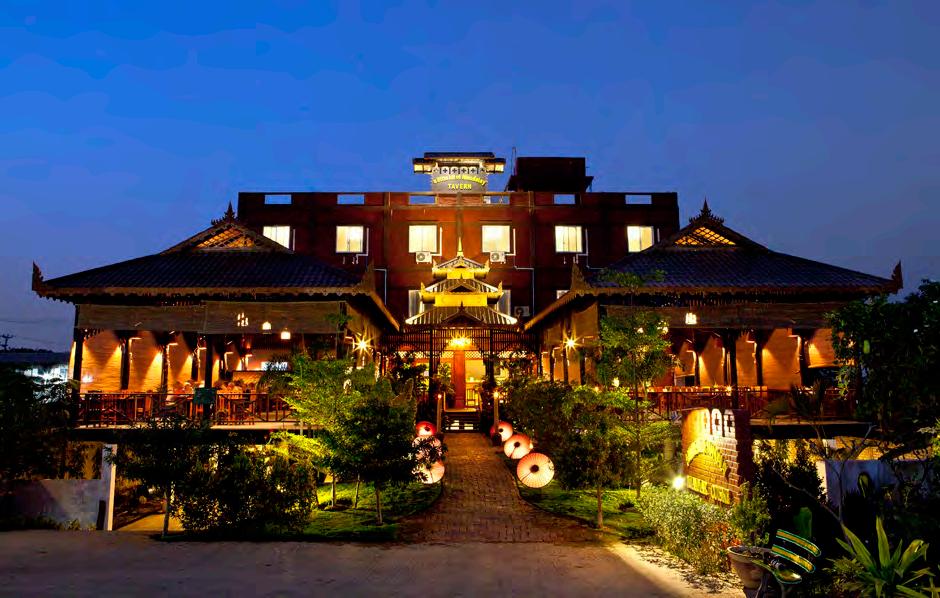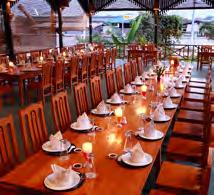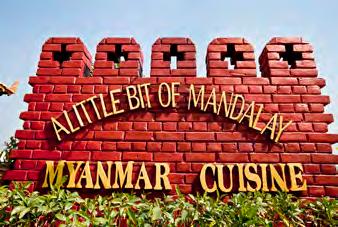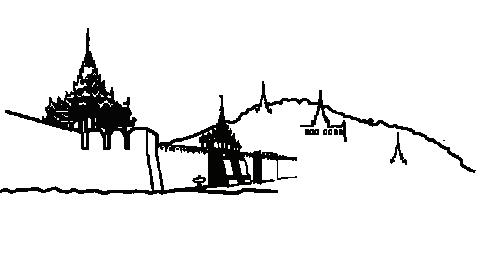




The Hotel @ Tharabar Gate is located in the most unique archaeological site of Southeast Asia, the ancient capital of the Burmese empire, Old Bagan.
Surrounded by more than 4,000 ancient temples and pagodas, you will be enchanted by the breathtaking views. The Hotel @ Tharabar Gate is within 5 minutes walking distance of the spectacular Ananda Temple, known as ‘The Jewel of Bagan.’
The hotel offers 83 luxury rooms, including 4 suites. Every room is decorated with teak floors and typical Burmese furniture.
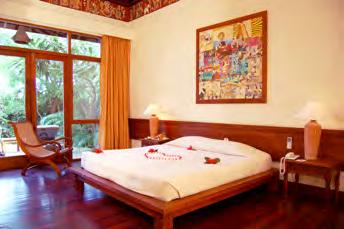


All rooms are fully air-conditioned and feature an IDD telephone line, satellite television, safety deposit box, mini-bar and a private garden. Each room comes with a high ceiling and different handpainted wall paintings, which are all copies of original temple paintings of the Bagan period. Internet and Wi-Fi is available in the lobby.
The hotel offers two dining choices: in the tropical garden and at the semi-open main restaurant. The restaurant accommodates 100 diners and a further 150 around the swimming pool and garden. The restaurant is well-known for its open-air fine dining, including traditional Myanmar food, European food and Asian cuisine. The hotel also features a pool-side bar to relax with a cool cocktail or drinks of your choice. Furthermore the hotel offers the option to order in-room dining at any time of the day or night.
For relaxation after a day of sightseeing we invite you to experience our spa with signature treatments from Myanmar and Thailand.
The 24-hour butler service will arrange the following for you: transport, guides, sightseeing tours, airline reservations, or a balloon ride with our partner, ” Balloons Over Bagan.” The hotel is a 15 minutes drive from Nyaung Oo Airport and most of the major sightseeing places for which Bagan is famous. We can also offer a sunset boat trip with snacks and drinks on board to watch the beautiful sunset over the Ayeyarwady, as well as excursions to Mount Popa (Taung Kalat).
Whatever you would like to do during your time in Bagan, we are here to make your visit an unforgettable one.

YANGON SALES & RESERVATION OFFICE
Room 2H, 1st Floor, Nawarat Condo, Sa Mon Street, 22/24, Pyay East Qtr, Dagon Township, Yangon, Myanmar.
Tel: (+95-1) 377956 / 376568, 09-450054234
Fax: (+95-1) 377830
THE HOTEL @ THARABAR GATE
Near Tharabar Gate, Old Bagan.
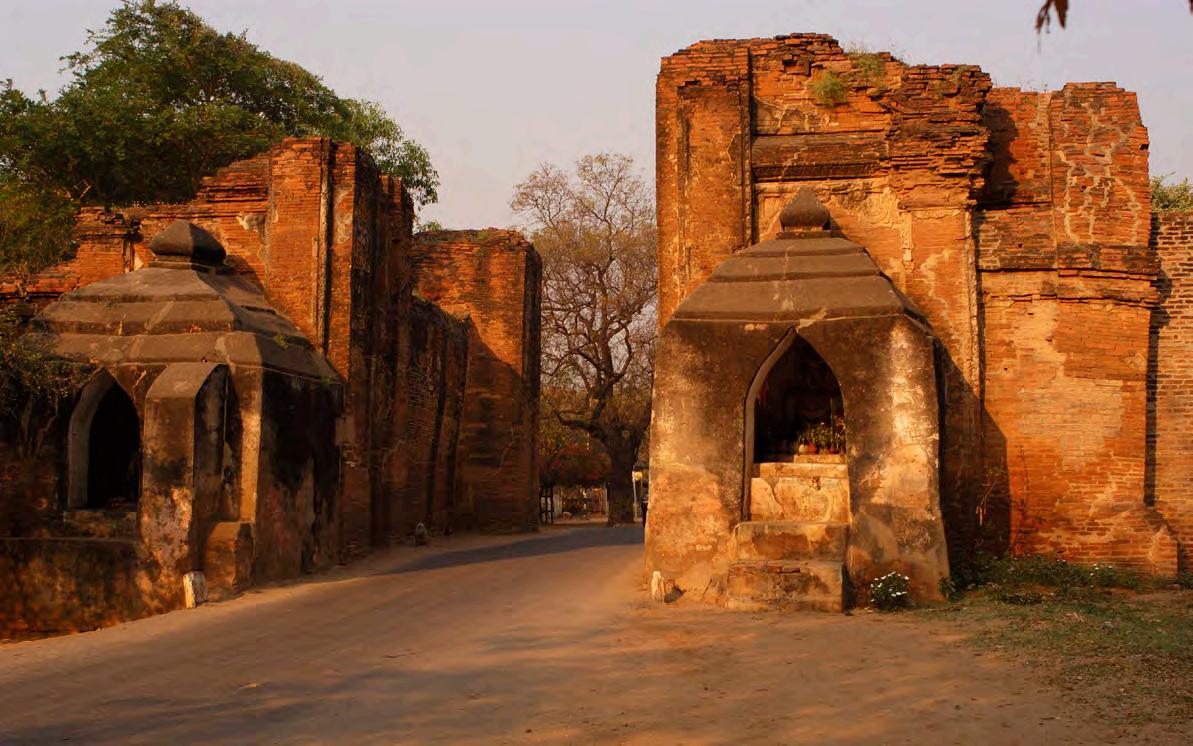
Tel: (+9561) 60037 / 60042 / 60043
Fax: (+9161) 60044
Email: smm@hoteltharabarbagan.com.mm reservation@hoteltharabarbagan.com.mm



Web: www.tharabargate.com www.hoteltharabarbagan.com



The Irrawaddy magazine has covered Myanmar, its neighbors and Southeast Asia since 1993.
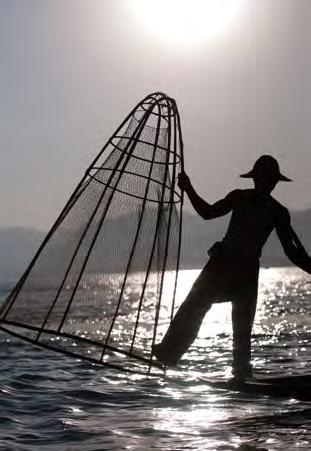
EDITOR-IN-CHIEF: Aung Zaw
EDITOR (English Edition): Kyaw Zwa Moe
ASSOCIATE EDITOR: Sandy Barron
COPY DESK: Neil Lawrence, Paul Vrieze, Samantha Michaels, Andrew D. Kaspar, Simon Lewis
CONTRIBUTORS to this issue: Aung Zaw; Kyaw Zwa Moe; Simon Roughneen; Kyaw Phyo Tha; Samantha Michaels; Virginia Henderson; Bertil Lintner; Nyein Nyein; Kyaw Hsu Mon; Grace Harrison; Jacques Maudy; Emilie Roell.
PHOTOGRAPHERS: JPaing; Steve Tickner; Sai Zaw; Teza Hlaing
LAYOUT DESIGNER: Banjong Banriankit
SENIOR MANAGER : Win Thu (Regional Office)
MANAGER: Phyo Thu Htet (Yangon Bureau)
REGIONAL HEADQUARTERS MAILING ADDRESS: The Irrawaddy, P.O. Box 242, CMU Post Office, Chiang Mai 50200, Thailand.
YANGON BUREAU : No. 197, 2nd Floor, 32nd Street (Upper Block), Pabedan Township, Yangon, Myanmar. TEL: 01 388521, 01 389762
EMAIL: editors@irrawaddy.org
SALES&ADVERTISING: advertising@irrawaddy.org
SUBSCRIPTIONS: subscriptions@irrawaddy.org
PRINTER: Chotana Printing (Chiang Mai, Thailand)
PUBLISHER LICENSE : 13215047701213
6
8
14
Myanmar: A Nation Living a Lie
REGIONAL
50
Vietnam Bets on Luring High Rollers
By relaxing anti-gambling laws, Vietnam’s government could give the country’s economy a US$3 billion boost
LIFESTYLE
52
Travel: A Day in the Dark
The Pindaya Caves in Shan State are the site of a six-day festival this month
54
Travel: Soak Up the Sea
A vast expanse of natural beauty and campfire dinners are among the charms of Ngwe Saung beach
56
Destinations: A Gateway-in-Waiting
A motorbike trip from India into Myanmar yields some surprises – mostly on the part of border officials
60
Food: Shan Yoe Yar Raises the Bar
A recent addition to Yangon’s restaurant scene sets a new standard for Shan cuisine
62
Society: A Walk in the Park
The successful revival of Maha Bandoola Garden park provides an inspiring example of citizen-friendly green space
64
Music: After Split, Me N Ma Girls
Power On
Remaining girls visit USA to record first album
16 |
Development: Myanmar Tourism’s ‘Crown Jewel’ Feels Strains of Growth
Bagan struggles to balance competing demands as visitors arrive in ever larger numbers
20 | Culture: Face to Face with the Tattooed Women of Chin

A journey to the remote villages of Chin State reveals faces inked in tradition but struggling against the hardships of isolation, poverty and government neglect
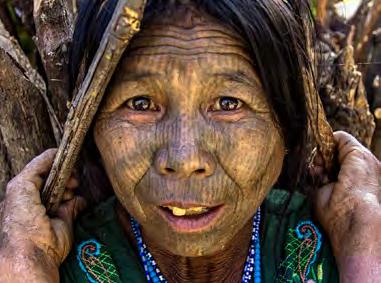
24 |
Society: The Safe Sex Talk, Myanmar Style
In a country where talking about intimacy is taboo, efforts are under way to develop a better system for educating youths about safe sex
28 | Society: School Hits the Road for Teashop Boys
A classroom on wheels offers poor children a chance to catch up on years of missed schooling
30 | Politics: A Federal Model that Fits
There are many forms of federalism in the world, but only one really matches Myanmar’s needs
32 | COVER For the Love of the Lake
Inle Lake is facing threats, but momentum is growing to preserve its natural beauty and cultural integrity
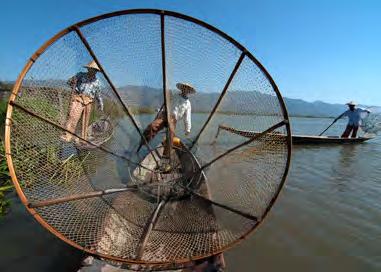
38 | Securities: Stock Market on Track, but Hurdles Remain

Much remains to be done before Myanmar launches Asia’s newest stock exchange in late 2015
46 |
42 |
Interview: A Tale of Retail Success
Money: Cleanliness: Not Always a Blessing? Money-changers’ insistence on crisp dollar bills mars the country’s image
48 | Roundup: Army Land Theft a Thing of the Past, Claims Govt
Relations between Myanmar and France date back to the early 18th century, but ties were largely on hold in recent decades due to Western sanctions on Myanmar’s former military regime. Since the current government introduced reforms after coming to power in 2011, however, the two countries have moved quickly to increase their engagement. The Irrawaddy recently spoke with France’s ambassador to Myanmar, Thierry Mathou, about his country’s growing role in Myanmar’s ongoing political and economic transition.
has always been keen to promote the principle and values of CSR [corporate social responsibility] that should become the motto of all investors in Myanmar.
What French investment has come to Myanmar since 2011, and what angles are prospective investors looking at now?
How would you describe the relationship between France and Myanmar today?
France-Myanmar relations are growing better every day. The number of French citizens living in Myanmar is booming: It’s now 65 percent more than last year. More and more companies are settling down here. French citizens are the most numerous European tourists to visit the country. President U Thein Sein’s visit to Paris last year, the first ever of a Myanmar head of state to France, was a milestone in the history of intergovernmental exchanges between our two countries. In 2012 we were honored to receive Daw Aung San Suu Kyi for her first trip overseas since her release from house arrest. Many other bilateral visits are in the pipeline. France is eager to engage with Myanmar in a very positive way in sectors such as economy, culture, education and health, while further promoting democracy and human rights remains very high on our agenda.
The release of political prisoners has been a condition for many Western governments to boost ties with Myanmar. President U Thein Sein promised to release all political prisoners by the end of 2013, but activists say dozens remain behind bars. What’s your take on the
situation? Will this affect French engagement here?
Obviously this is still an issue. Hundreds of political prisoners have been released since 2011. We have acknowledged and praised this unprecedented trend. Forming the Review Committee for the Release of Political Prisoners (RCRPP) was also a significant step. Yet all remaining political prisoners have to be released and arbitrary arrests have to be ended. Freedom of conscience must have no boundary.
The French oil giant Total faced some criticism from the international community for its work in Myanmar during the former military regime. Did the French government ever consider trying to persuade the company to divest?
Oil and gas companies are engaged in long-term strategies that involve commitments over several decades that are different from governments’ approaches. In the case of Total, the implementation of the Code of Conduct has always been very important for the French government. I notice that Total’s Socio-Economic Program is now described as an example by many stakeholders, both in Myanmar and abroad. In that respect France
The number of French companies coming to Myanmar is increasing rapidly. Large companies like Accor, Alstom, Bouygues, Lafarge, L’Oreal, Schneider Electric, Technip and many others are already in place. SMEs [small and medium enterprises] are also studying the market. Others are to come. The French-Myanmar Business Association, which used to be the oldest Western business association in this country, will soon become a full-fledged chamber of commerce under the name of the FMCCI [French Myanmar Chamber of Commerce and Industry]. Yet like others, French companies need improved macroeconomic and sectorial policies, better legal stability and more transparency, to invest in the long term on a larger scale.
Myanmar Posts and Telecommunications (MPT) has held partnership talks with several international telecoms firms, including France Telecom. Can you tell us more about that?
Orange (France Telecom) is a worldclass telecoms player which has unique experience in the transformation of incumbents worldwide in countries that face similar challenges as Myanmar. For that reason it has proposed a partnership to MPT that would enhance its strategic and business development which is crucial for MPT to face its new competitors. We have many reasons to think that Orange’s proposal is by far the best for MPT. The decision is up to the Myanmar government.
France co-chairs the sectoral working group in Myanmar on women’s empowerment. Over the past year there have been
continuing reports of rape in conflict zones, and women have remained largely sidelined during the peace negotiation process. What steps are being taken to address these issues?
France has chosen women’s empowerment as one of its priorities in Myanmar because it is a very concrete way to promote democracy and human rights. The Women’s Forum we organized in Yangon last December was an occasion to highlight the role of women in the peace-building equation. It showed that in a 2013 review of major peace processes around the world, less than 9 percent of negotiators were women. Myanmar is certainly not an exception. I was pleased to notice that thanks to the consistent advocacy of NGOs, the Kachin Independence Organization (KIO) has decided that one-third of its central committee members would be women. This type of decision has to be amplified and implemented in all organizations, including government. But men’s resistance is not always the problem. Women often have to be convinced. We will pursue our gender advocacy as we will defend women’s rights wherever they are in danger.
In the coming year, what can the Myanmar government do to encourage more French engagement?

We understand that genuine democracy cannot be created overnight. In that respect we acknowledge the step-bystep approach implemented by the government. But new major steps await Myanmar in 2014. As far as the peace process is concerned, we are looking forward to the long-awaited political dialogue which has to start as soon as the national cease-fire agreement is signed with clear and ambitious objectives that respect the rights of ethnic groups within the framework of national unity.
The ability of Myanmar to amend its Constitution in a way that demonstrates its willingness to further engage on the path of democracy and to implement much-needed changes in the interests of the people will also be closely watched. Any other approach would come as a disappointment both at home and abroad. Creating unnecessary delays and keeping restrictive clauses would be a bad signal.
Last but not least, we are looking forward to knowing the content of the Comprehensive Strategy and Action Plan for Rakhine State that the government has agreed to share with international partners, so that a solution can be found to the current crisis and we can offer our support.
France has signed an agreement with Myanmar to help strengthen freedom of expression in the country by offering technical advice on media laws. How free
is the Myanmar press today, and what is your opinion of draft media laws currently being considered by Parliament, including the printing and publishing registration bill?
Freedom of expression is coming a long way in Myanmar. Much progress has been made during the last three years, but many challenges lie ahead. France has a very simple stand as far as media laws are concerned: Always protect rights, never restrain liberty. Training is also essential in a world where journalists have to be responsible and independent actors of civil society. This is why France has taken the initiative with other partners to initiate the first School of Journalism in Myanmar that will soon open in Yangon.
When President U Thein Sein met President Francois Hollande in July last year, Mr. Hollande reportedly expressed concerns over the treatment of ethnic and religious minorities. How would you rate the Myanmar government on its response to reports of violence against Muslims since then?
Growing violence between religious minorities is a serious concern, especially in Rakhine State, where fear is on both sides. This situation should be addressed without delay through a “local peace process.” First, bring people around the table and stop violence. Then discuss political issues, with no taboos, with the objective to bring long-lasting peace, stability and development in Rakhine while addressing concerns and respecting rights of both Buddhist and Muslim communities. Otherwise the current crisis could become a major problem for the overall transition process in Myanmar.
PHOTO: JPAING / THE IRRAWADDYPeople in Myanmar expect a bumpy ride in 2014 as the “big four”— Daw Aung San Suu Kyi, U Thein Sein, U Shwe Mann and Commander-in-Chief Snr-Gen Min Aung Hlaing—are likely to compete and divide the nation.

The armed forces chief’s political ambitions remain a mystery. The falling-out between Daw Aung San Suu Kyi and U Thein Sein is seen as a bad omen. Ambitious Union Speaker U Shwe Mann is seeking to amend the controversial 2008 Constitution.

–U Thein Myint, a trustee of the Maha Wizaya Pagoda, built by former dictator Gen. Ne Win in 1980, in the shadow of Yangon’s revered Shwedagon Pagoda
–U Ohn Myint, the minister of livestock, fisheries and rural development and a former general, in an angry exchange with villagers that was captured on video
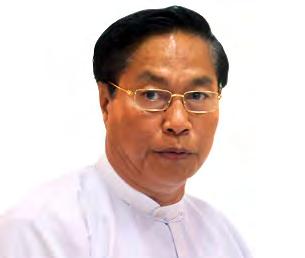
“I am Gen. Ohn Myint and I’ll dare to slap anyone in the face.”
“We earn less than US$10 per month in donations from occasional foreign visitors.”
“Frankly…it was clear that there are some who are committed to a reform process, and others who would like to shut it down.”
–Kenneth Roth, executive director of Human Rights Watch, talking to reporters after meeting senior government officials in Naypyitaw

Myanmar’s Ministry of Information (MOI) has started denying requests for three- to six-month journalist visas for foreign passport holders who work at formerly exiled media groups, in a move seen by
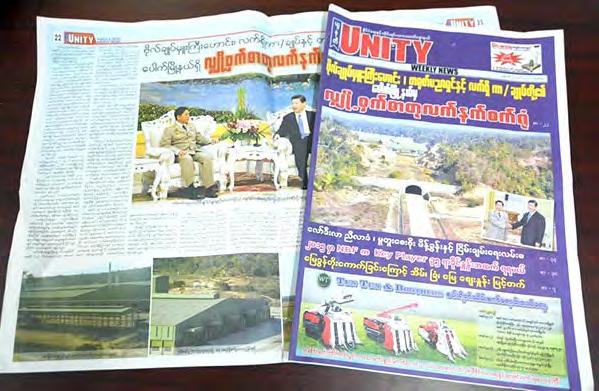
some as part of a government effort to rein in the country’s media. “I only got 28 days,” said U Toe Zaw Latt, an Australian passport holder who works as the Yangon bureau chief for the Democratic Voice

of Burma (DVB). Editors from The Irrawaddy were also affected by the new restrictions. Foreign and domestic media observers say that the MOI is growing increasingly wary of critical reporting in the wake of a relaxation of draconian press rules since the country started opening up in 2011. In early February, four reporters and two executives from the Yangon-based Unity journal were arrested in connection with a report on an alleged chemical weapons factory in central Myanmar. The government denied the allegations, but said the arrests were valid under the 1923 Official Secrets Act.
Around 200 people who had built houses on militaryowned land in the popular beach area of Chaung Tha in Ayeyarwady Region were sued for trespassing in late January. The local residents allegedly built fences and houses on about 34 acres (13 hectares) of land in Chaung Tha that was transferred to the army about 18 years ago. Sources close to some of the defendants said that 209 people had been charged

with trespassing by the army’s Southwest Regional Command, in a case that has been under investigation since 2012.
The Myanmar government is preparing to submit three new wetlands areas for recognition under the Ramsar Convention, which protects wetlands of international importance. The 100-square-kilometer Moeyingyi Wetland Wildlife Sanctuary in Bago Region is currently listed as a Ramsar Site, but Minister for Environmental Conservation and Forestry U Win Tun said that Myanmar was surveying Indawgyi Wildlife Sanctuary in Kachin State, the Meinmahla Kyun Wildlife Sanctuary in Ayeyarwady Region and the Gulf of Mottama (Martaban) so
that they could also be considered for inclusion on the Ramsar List of Wetlands of International Importance. He made the remarks on Feb. 2, World Wetlands Day.
political demands around the country and warned these actions could lead to unrest. “Some discussions can lead to disagreements. If the disagreements cannot be solved in Parliament, it will spread to outside of the Parliament [and] there can be demands, riots and violence by groups of people,” the president wrote. “When these cases happen, we will face pressure from local and foreign media on our government.”
In a top secret document leaked to The Irrawaddy, President U Thein Sein warned his government that the country could face mass protests and violence as calls to amend the military-drafted 2008 Constitution grow stronger. It said that activists are mobilizing support for their

Police in Malaysia said they were investigating the attempted assassination of two ethnic Rakhine political leaders from Myanmar after shots were fired at them in Kuala Lumpur on Feb. 5. Dr. Aye Maung and U Aye Thor Aung of the Arakan National Party were just leaving a shopping center in
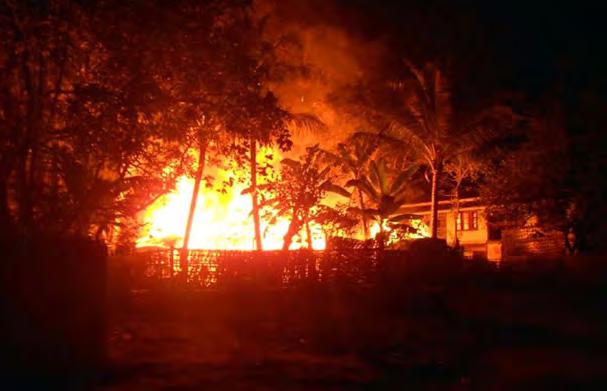
A government commission set up to investigate violence in Rakhine State in mid-January will try to establish the “root cause” of the death of a policeman said to have been killed by a Rohingya mob on Jan. 13, but did not say if it would address allegations made by the United Nations that almost 50 Rohingyas were killed in related violence. The commission, which was announced in state media on Feb. 7, was expected to report its findings to President U Thein Sein by the end of the month. An earlier investigation by the
Myanmar National Human Rights Commission found no evidence that alleged
massacres of Rohingyas in the village of Du Chee Yar Tan took place.
the Malaysian capital when the incident occurred. They both escaped unharmed after two gunmen on a motorcycle opened fire on them. At a press conference held in Yangon two days later, Dr. Aye Maung said the attack might have been related to the situation in Rakhine State, where tensions have been high since the outbreak of communal violence between Rakhine Buddhists and Rohingya Muslims in June 2012. Several attacks on Myanmar nationals living in Malaysia have been reported since the violence in Rakhine State began.
Myanmar’s largest ethnic armed group, the United Wa State Army (UWSA), has selected 30 soldiers to receive pilot training in China, according to sources who visited the group’s headquarters on the Myanmar-China border. Senior military officers from two ethnic armed groups told The Irrawaddy that UWSA officials informed them of the plan during a visit to their headquarters at Panghsang in Shan State in January. In April of last year, Jane’s Intelligence Review reported that China had delivered several Mil Mi-17 ‘Hip’ medium-transport helicopters armed with TY90 air-to-air missiles to the UWSA. Both China and the UWSA have denied the report. The UWSA is the largest ethnic rebel group in Myanmar, with an estimated 25,000 soldiers. It signed a ceasefire agreement with the government in late 2011.
PHOTO: MYANMAR MINISTRY OF INFORMATION A fire in the western part of the village of Du Chee Yar Tan in Rakhine State destroyed 16 homes on Jan. 28. PHOTO: REUTERS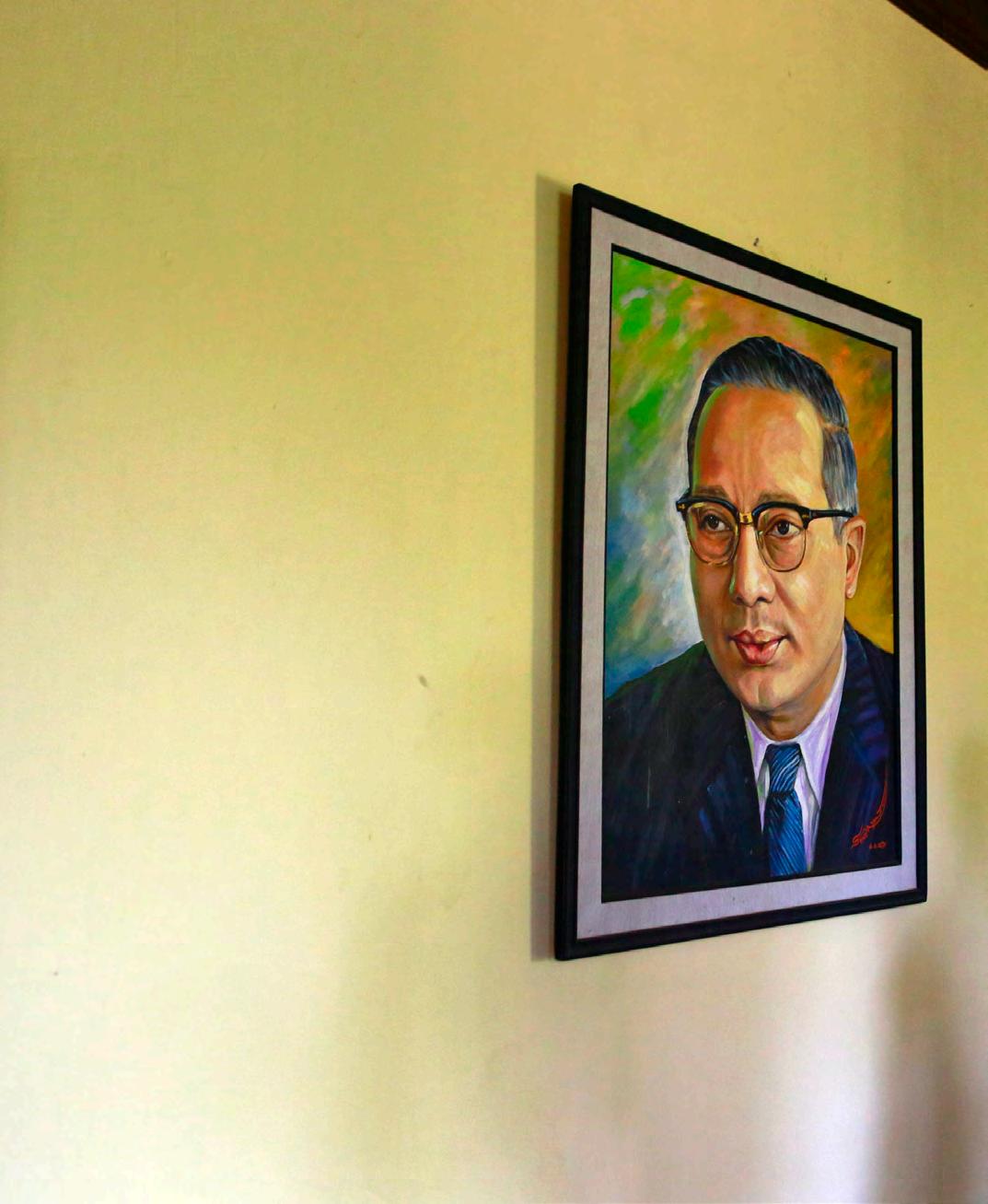
A Buddhist monk looks at a portrait of U Thant in the Yangon home of the former United Nations secretary-general (19611971) on Feb. 2, 2014, during celebrations held to commemorate the birth and legacy of one of Myanmar’s most respected statesmen.


in 1962. At the time, socialism was a popular ideology in many parts of the world, so he simply adopted it as a way of legitimizing his military dictatorship. Sadly, he fooled even real socialists—or rather, they fooled themselves—into accepting his bizarre brand of misrule as a serious attempt to turn Myanmar into a socialist state.
After Gen. Ne Win was forced to step down in 1988—and a handpicked set of generals quickly stepped in to fill his shoes—the new regime continued to rule through a combination of brute force and brazen mendacity. Army officers who slaughtered civilians were called heroes, and dissidents were labeled terrorists and thrown in prison. Did anyone really believe this? Probably not. In fact, one of the few good things you can say about the post-1988 regime is that its lies were so blatant that the general public wasn’t even tempted to be persuaded by them. But the generals were so insistent on their version of history and their role as “saviors” of the nation that most people simply held their tongues rather than argue with them and risk imprisonment or worse.
The people of Myanmar live in a complex society where right and wrong are often impossible to tell apart. We are so accustomed to being lied to that we no longer know what to believe. Perhaps people in other countries also feel this way sometimes; but in Myanmar, there is an almost palpable sense that this is a society mummified by a web of lies.
The truly disturbing part of this is that sometimes we can’t seem to avoid being complicit in these lies. Whether we consciously accept falsehoods or simply fail to challenge them, we contribute to the way that we encase ourselves and others in dangerous delusions.
A good example of this was when Gen. Ne Win introduced his “Burmese Way to Socialism” after seizing power
These days, the situation is more complicated. Now everybody professes to want democracy, even the generals who spent half a century crushing it. Late last year, for example, the commander-in-chief of the armed forces, Snr-Gen Min Aung Hlaing, was quoted by Radio Free Asia as saying that he wanted “real, disciplined democracy.” But you really have to wonder if the word “democracy” means the same thing to him as it does to all those who have struggled for decades to achieve it, and for the millions in Myanmar who have lived their entire lives deprived of even the most fundamental rights.
We are supposed to believe that Myanmar today is a country reborn, that its rulers have seen the light and are now intent on introducing democratic reforms. But even though there have been undeniable changes since a “civilian” government of exgenerals assumed power in 2011, how can we be sure that those who still

have their hands firmly planted on the steering wheel are really taking the country in the right direction?
The truth is that the current “transition” in Myanmar is built upon a foundation of lies—lies that the country’s people were forced to accept as the only way out of a desperate situation.

The first of these lies was perpetrated a week after Myanmar experienced the worst natural disaster in its long history. In a rigged referendum held on May 10, 2008, a nation traumatized by Cyclone Nargis supposedly voted overwhelmingly in favor of a militarydrafted constitution that enshrines a leading role for the armed forces in political affairs.
Then, in November 2010, the nation voted again, this time for a new government. Unsurprisingly, the military-backed Union Solidarity and Development Party (USDP) won by a landslide.
At that stage, no one had any reason to believe that anything had really changed. But after President U Thein Sein assumed office the following year, he started sending signals, such as releasing political prisoners and relaxing controls over the media, to indicate that he was a new kind of leader, and that the bad old days of arbitrary military were truly over.
Eventually, even Daw Aung san Suu Kyi, whose National League for Democracy had boycotted the 2010 election, was sufficiently convinced of the president’s sincerity that she decided to contest in by-elections in 2012, even though her party only stood to win a tiny handful of seats in the overwhelmingly USDP- and militarydominated Parliament.
Now, nearly two years later, we find ourselves in the peculiar situation of half-accepting a political system that we know is no more than an extension of the former illegitimate regime. Even journalists who once fought for media freedom are now happy to buy into the Ministry of Information’s efforts to treat the press as a “public service” that needs to be regulated.
On the subject of constitutional
change, we no longer dare to question the legitimacy of the 2008 Constitution itself. Instead, we call for amendments to specific clauses, such as the one that makes Daw Aung San Suu Kyi ineligible for the presidency because she has two foreign-born sons.
Some in the government have lent a sympathetic ear to calls for changes to the Constitution, although so far none have been willing to do more than pay lip service to the need for reform. Meanwhile, the USDP has ominously warned that any attempt to tamper with the charter could result in “bad consequences.” We all know what that means: in a worst-case scenario, a return to outright military rule.
Because we dread a reversal of the modest progress of the past few
of military rule, which has left some minds so scarred that they can no longer conceive of a political system that doesn’t have a tyrant at its center.
But the people of Myanmar cannot allow themselves to be influenced by such weak reasoning, which is no more than a cover for cowardice. We all know the fear of speaking our minds in a country where that has long been a crime, but it is past time that we stopped being afraid of the shadows of a regime that now feels a need to hide behind a veil of democratic respectability.
We know what we want: a democratic constitution, free and fair elections, and a government that is truly chosen by the people. What we don’t know is how or whether we
years, we are afraid to boldly speak out for more meaningful changes to the political system. To conceal their own timidity, some intellectuals have even tried to rationalize acceptance of the status quo by arguing that letting the supposed “moderates” among the exgenerals hold on to power indefinitely is the best way to ensure that the country doesn’t fall back into the hands of the hardliners.
It’s difficult to know what to make of such an absurd argument. Perhaps the most generous thing we can say is that it is a product of half a century
can achieve these things. And in our self-doubt, we may be tempted to do what we have always done: accept lies as truth and simply hope that we will one day enjoy the freedoms that other countries take for granted.
If that is the approach we choose to take, then we can always take comfort in one thought: Even if we don’t get the government that we want, we will at least have the government we deserve.
Kyaw Zwa Moe is the editor of the English-language edition of The Irrawaddy.With several dozen A4sized paintings weighed down with stones on the cobbled forecourt of the Shwegu Gyi pagoda, artist U Aung Aung offers visitors to the shrine an affordable souvenir of their visit—a commissioned painting of the temple for a fee of 10,000 kyat or less.
He and brother U Soe Lwin run an impromptu gallery and art shop outside one of the bigger temples making up Bagan’s panoply of around 2,500 mostly red- and brown-bricked pagodas—a renowned tourist draw

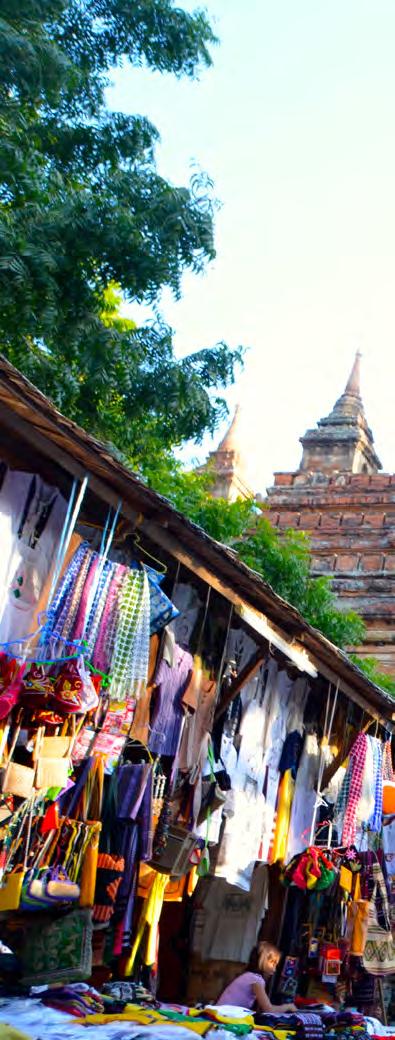
pulling in around 200,000 visitors in 2013, up from 160,000 the year before.
The brush-wielding brothers depend on the tourist season, which runs from around mid-November to mid-February, with numbers dropping sharply around March or April when temperatures in Bagan, situated on a river bend in Myanmar’s parched dry zone, hit toward 40°C (104°F).
“Some days five, some days 10, some days maybe one or two,” U Aung Aung said, discussing how many paintings the siblings sell each day.
But the presence of the brothers—
along with other hawkers around this and other landmark temples in Bagan— is a reminder that visiting Bagan has its downsides, for some.
Women selling lacquerware souvenirs and men propped up on parked bicycles shout entreaties at passersby, or, unsolicited, provide tourguide services around the temples, after which the expectation is that the visitor will repay their expertise by purchasing some of their wares.
Unwrapping a palm-sized sheet of white paper, one man who gave his name as “U Tun Tun” whispered, “I
have orange sapphire, ruby, jade. The ruby is for US$120.”
Some might say such in-yourface bartering is part of the charm of visiting a long-closed former military dictatorship.
But Dr. Donald Stadtner, author of Sacred Sites of Burma, a book about Myanmar’s religious buildings and locations, is among those who are put off by the hawkers around Bagan’s temples. The buildings themselves—Bagan’s main attraction—are compromised, Mr. Stadtner feels, by shoddy renovations carried out during Myanmar’s period of
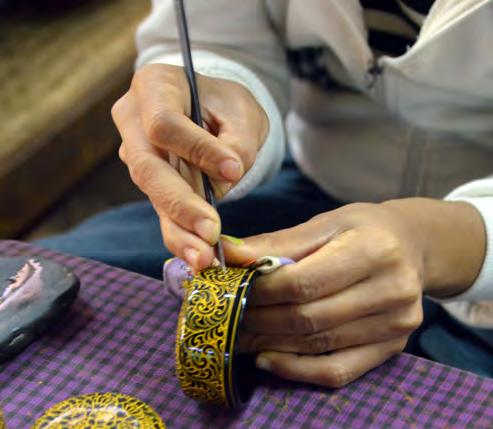


military rule, partly to replace pagodas damaged in a 1975 earthquake, and partly to modernize the ruins in a display of piety.
“Thousands of temples have been restored at Bagan but with little attention to historical accuracy. [Changes are] based far too much on conjecture, and temples and stupas no longer preserve their original appearance,” he said.
Visitor numbers are increasing, and if the government’s hopes of attracting 7 million tourists a year by 2020—more than three times the 2 million foreign visitors who came during 2013—come to fruition, Bagan will likely see around 1 million visitors a year within that time.
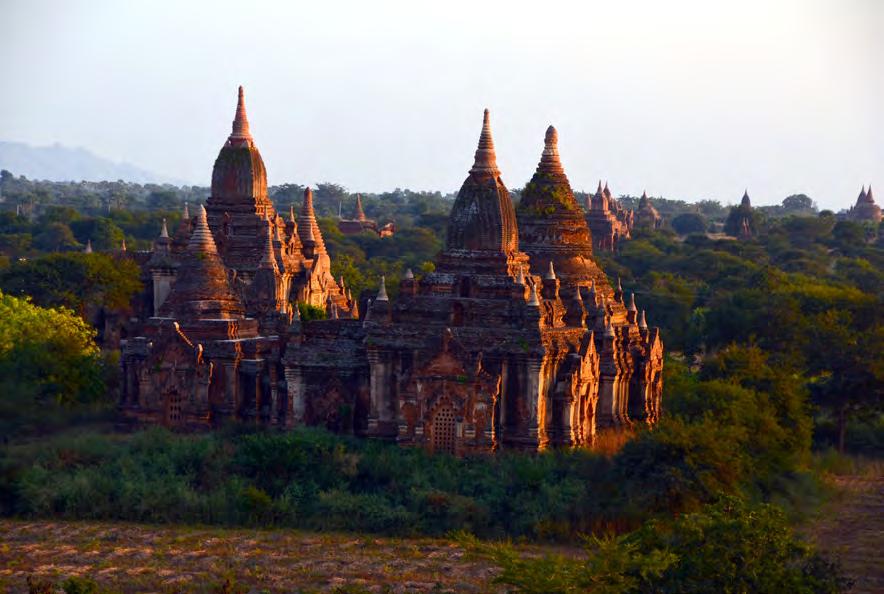
As things stand, the area’s three small towns—Old Bagan, New Bagan and Nyaung-U—might struggle to cope with such an influx.
Brett Melzer, co-founder of Balloons Over Bagan, whose hot-air balloons give tourists a chance to see the temple-studded plain below in all its dusty, ethereal glory, reckons tourism development in Bagan should not focus on just numbers of visitors.
“As it currently stands, there isn’t the capacity to deal with a greater influx,” he said. Describing the region as “a crown jewel for Myanmar,” he suggested that in future Bagan tourism focus “on quality rather than just
growth.”
Land prices are going up, as demand for sites to build hotels, shops and restaurants grows in tandem with the tourism upsurge and in anticipation of lucrative future yields.
U Hla Min, manager of the Seven Diamond travel agency branch in Nyaung-U, said that business has gone up “by around 60 percent” since 2010, the year before Myanmar’s government began a series of reforms that have facilitated increased tourist arrivals.
But, he says, hotels are too expensive, something he fears will put visitors off, just as much as Bagan’s flawed renovations or pushy hawkers.
“Minimum is 50, 60 dollars a night,” he says, putting the costs down to land prices. “One square meter is five lakhs [500,000 kyat] in Old Bagan, for Nyaung-U maybe a bit less,” he said.
Building in the region requires a permit, meant to ensure that the proposed new structure does not add to the ill-advised eyesores built during military rule—termed “blitzkrieg archaeology” by renowned Myanmar historian U Than Tun.
The upshot of putting hotels and golf courses in among all those temples was that a bid to have Bagan listed as a Unesco World Heritage Site fell flat, though there is a chance that it could yet receive the prestige-laden accolade if another application is made.
Elizabeth Moore, professor of Southeast Asian art and archaeology at the School of Oriental and African Studies in London, believes that Bagan is worth putting forward again for this toptier recognition of its world-class cultural status.
“It is unique, perhaps complements Angkor, but is a classic Buddhist royal center of learning. The dispersed villages and royal enceinte make an ancient and living cultural landscape in my view,” she told The Irrawaddy.
But with elections coming up in 2015, winning Unesco’s imprimatur is probably less of a priority for the government than speeding up the business side of Bagan’s tourism development. Jobs are still scarce in what remains one of Asia’s poorest countries, with the unemployment rate estimated at 37 percent, so tourist draws such as Bagan have to be brought into the government’s job-creation thinking.
But U Tun Aung, the general manager of the Riverside Hotel, which sits on a hill overlooking the Ayeyarwady River and a busy dock where boats take piles of the renowned local lacquerware to be sold in Mandalay, said that there is a tension between those who focus on preserving Bagan’s archaeological purity and others whose first priority is business.
“The Culture Ministry says it wants to protect the zone, but the hotels and tourism sector wants to build the hotels,” he said.
He added that people in the hotel business understand the need to preserve the look of the region, but at the same time don’t like the delays imposed by the government.
“We would like to follow the regulations, but too much is a waste of time, as we need to move quickly,” he said.


A journey to the remote villages of Chin State reveals faces inked in tradition but
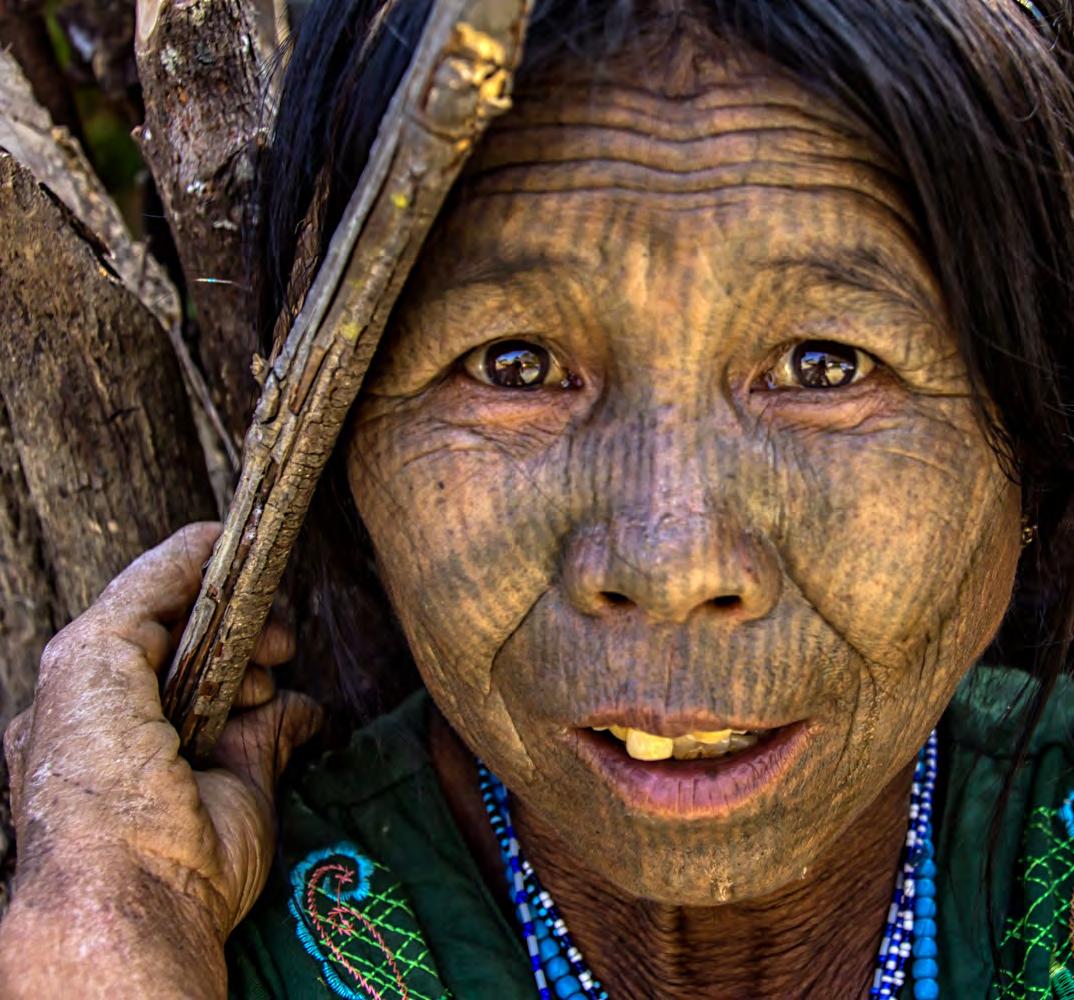 By JACQUES MAUDY / KANPETLET AND MINDAT TOWNSHIPS, Chin State
By JACQUES MAUDY / KANPETLET AND MINDAT TOWNSHIPS, Chin State
Iwas told before setting off for Chin State that it was one of the poorest and most isolated regions of Myanmar. I thought I was prepared for this, but as is often the case, facile descriptions failed to do justice to the reality on the ground.
My purpose was to document the tattoo-faced women of Chin. The women we met belonged to six tribes in the southeast of the state, concentrated around the townships of Mindat and Kanpetlet. There are some 12 Chin tribes that once practiced facial tattooing, spread between northern



Rakhine State and southeastern Chin State. The tattooing survived long after the Myanmar government officially forbade it in 1960. Traditional tattooists were still active until the mid-1990s, and I met one 30-year-old woman whose face was inked just 15 years ago.
Access to Mindat from Bagan in Mandalay Division is easier than reaching Kanpetlet. For either destination, a four-wheel drive vehicle is a must. Expect hours of bumpy dirt tracks, river crossings
Not far into the journey, you get the sense that Chin State has been forgotten by the central government. Others say it is a voluntary isolation, until recently at least. Chin State is predominantly Christian but also strongly animist, and many here complain of religious discrimination from Naypyitaw and its mostly Buddhist leaders.
A road is under construction from Mount Victoria and nearby Kanpetlet to Seikphyu on the Ayeyarwady River, but it will be at least three years before you can cruise with ease up to Mount Victoria (Nat Ma Taung) National Park, which hosts Chin State’s tallest mountain. Today it is a harrowing four hours along a dusty and rock-strewn route that hardly qualifies as a road.
But at least, many locals say, things appear to be moving in the right direction. The absence of roads is the most immediate complaint from locals, along with a lack of medical assistance.
Muun, Daai and Makaan tribeswomen are easily spotted in Mindat and the villages around it. Muun women display a distinctive P-shaped pattern on their cheeks and a Y symbol on their foreheads that mirrors an animist totem carved and planted in their villages. Faithful to their animist traditions, the Muun must celebrate at least one weeklong sacrificial ceremony during their lifetimes in order to appease the spirits and secure their place in the afterlife.


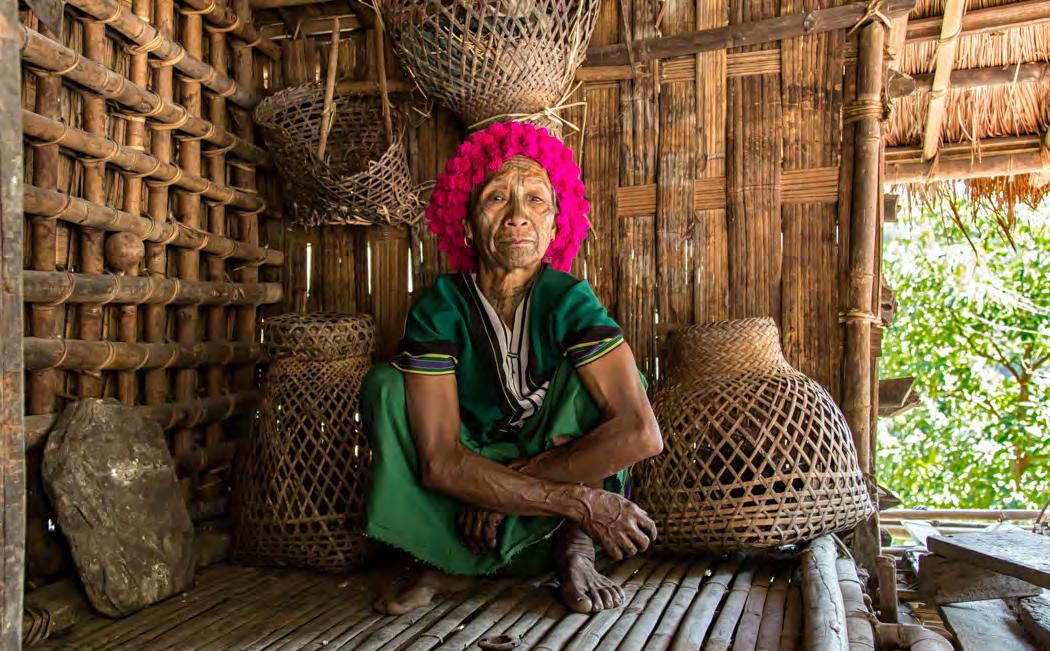
During that week, they will successively sacrifice a chicken, a goat, a pig, a buffalo and a buffalo captured from the wild. They will invite the shaman and fellow villagers to feast on the meat and will collect flat stones from the riverbed to build their own “House of Spirits” at the edge of the village. If this ritual is repeated in the course of any one villager’s lifetime, the observer gains the privilege of building his House of Spirits next to his home.
Though strongly committed to animism, most Muun are simultane-
ously Christian. One example of how this mixed religious tradition manifests itself is in the burial practices of the Muun. After the deceased is buried in accordance with Christian tradition, his body will the next day be dug up by friends and cremated, with the bones and ashes laid to rest under the stone stool of his or her House of Spirits. Chin State is perhaps the only place in the world where the cemeteries are empty. Makaan tribeswomen sport a spotted tattoo pattern forming lines on their forehead and chin, while Daai women
display a face covered with dots that are mixed with vertical and horizontal lines on the forehead and cheeks.
Ngagah, Daai, Muun, Yin Duu Daai and Uppriu tribes all live in the villages surrounding Kanpetlet.
Yin Duu Daai tattoos consist of vertical lines, including on their eyelids, while Uppriu women’s faces are completely covered with dark ink and Ngagah tattoos are a mix of vertical lines and dots.
Local lore has it that that these tribes first began to ink their faces as a way of disfiguring their beauty to avoid being kidnapped by the Myanmar king. A second legend states that they were tattooed distinctively to allow for identification with their tribe of origin in the event that they were kidnapped by another tribe. The latter seems more plausible, as this region has been visited by a Myanmar king only once, centuries ago. In any case, these women had to bravely withstand many hours of pain to have the ink embedded into their skin with citrus thorns.
While I was walking the threehour stroll from Mindat to the village of Kyar Do with Naing Htang, the son of a wealthy Mindat farmer, I noticed that huge chunks of the native forest had been cut down and sometimes replaced by bean or corn crops. Naing Htang explained that local farmers clear the forest to plant—and not long after exhaust—the newly made arable land. The fields’ soil stays fertile for just three years, after which the farmers are forced to move and plant their seeds on a new plot.

In this way, some 70 percent of the forest has been already cleared. After a cycle of nine years, farmers often return to the original block to re-plant, but the harvest’s yield is much lower. The monsoon season’s heavy rains wash the top soil down the land’s steep slopes, making that which is already unsuitable for farming even poorer. A high fertility rate of five children on average per couple adds demographic pressures on the land.
Naing Htang added that the area’s climate was becoming more arid as a direct result of the deforestation. He suggested that a solution would be to cultivate using terraced planting
techniques, which would help retain nutrients and top soil, and in turn eliminate the need for rotational farming. But for this they need better road access and machinery, and neither is so far forthcoming. In Naing Htang’s opinion, the farmers were aware that they were destroying their own environment but did it “for survival,” as he put it, rubbing his belly.
As we reached Kyar Do village, we heard hymns coming from a timber church up the slope. It was Sunday, and all the women of the village would be gathered there for the weekly service.
We joined the mass and witnessed the Christian fervor of the also-animist villagers. After the service I sat down with the priest, Law Aung, who had been preaching passionately a few minutes earlier. I asked him why the Chin people cling to livelihoods on these inhospitable slopes. He responded that it was to protect themselves from their enemies. When I asked him what could be done to improve the lives of his people, he went silent, and remained that way for so long that I repeated the question, thinking he hadn’t understood the query.
“If you could ask for one thing to improve the lives of the villagers, what would it be?”
“Too many things to ask,” he finally replied. “A road and flatter land.”
I asked what he envisioned for the future of the village.
“No future. The land will go down to the river one day and we will have to move elsewhere,” he gloomily predicted.
A community development team from Naypyitaw that I met in Kanpetlet was startled at the sight of my photos of the tattooed Chin women. They didn’t seem to know of these women’s existence. We told them about the situation in Kyar Do, preparing them for what they could expect to see in the surrounding villages.
Since last year, the villagers have been using a few 300,000-kyat (US$300) Chinese-built motorbikes to link the surrounding villages to Mindat. Small solar panels are providing some electricity to the largely off-grid people, and the villages have acquired a few mobile phones. But these changes, and the road the government is building a few hours’ walk away, may be too little, too late for the faces in this remote corner of Chin State.
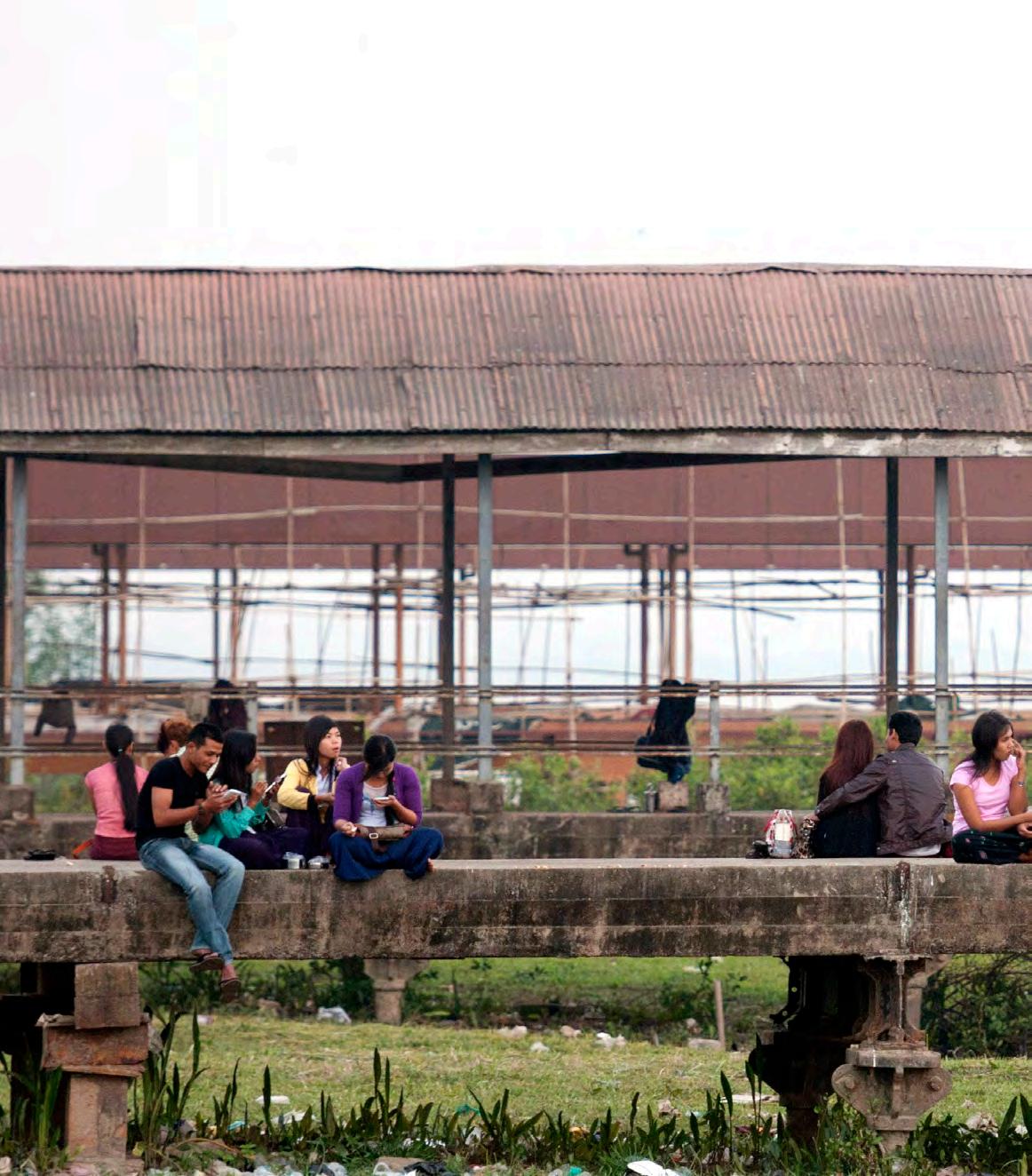
In a country where talking about intimacy is taboo, efforts are under way to develop a better system for educating youths about safe sex
By SAMANTHA MICHAELS / YANGONAs a teenager, Ma Pan Ei Khaing never walked too close to boys, heeding a word of advice from her mother about unintended pregnancy.
Her friends in her native Bago Region were told by their parents not to have sex. “But my mother said that once I started menstruating, I couldn’t even touch a man, otherwise I would become pregnant,” she says. “I was afraid of that, so I stayed away.”
She busted that myth three years ago, when she turned 18 years old and decided to study health so she
could become a midwife. But today, despite her training, and although she believes communities would benefit from discussions about contraception, she is not widely sharing information about safe sex with patients.
In some parts of Myanmar, mainly urban centers, health-care workers discuss methods of preventing sexually transmitted diseases. But in the rural areas where Ma Pan Ei Khaing works, and where midwives are the sole providers of medical care, safe sex is not considered an acceptable subject for discussion.
U Sid Naing: ‘Schoolteachers are embarrassed.’
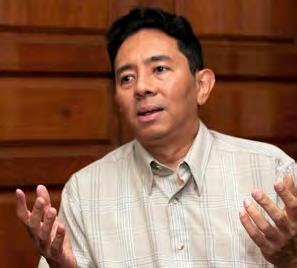
Below: Young people relax around Botataung port area in Yangon.


“The topic is a little strange,” she says. “And using condoms is seen as shameful. In this traditional culture, if you have sex before you marry, it’s like you did something wrong.”
In Yangon a young doctor has taken a different approach. To avoid the embarrassment of speaking face to face, he moderates a telephone advice hotline for young men who have questions about sexual health. The hotline is an initiative of the Myanmar Medical Association, an organization of physicians that has also created a separate line for women.

Some callers are shy at first, says 26-year-old Ko Zarni Win, who answers about five calls daily for the boys’ line. “They do not need to tell me their name so they can easily disclose their problems,” he says.
But the hotlines are not a cureall because a majority of people in Myanmar lack access to mobile phone networks, and other options for frank discussions are limited. Parents typically do not talk to their children about reproductive health, and although sex education is taught in schools, teachers worry their integrity could be questioned if they speak openly about the subject.
Myanmar is trying to answer a question that remains controversial in many countries: how to balance calls for comprehensive sex education as a tool to prevent teen pregnancies, sexually transmitted diseases and sexual violence, with concerns about protecting cultural values.

Myanmar women are traditionally expected to remain virgins until they marry, and while condoms are available in stores, young adults say they fear being labeled as promiscuous if they are caught with one in their bag.
Mi Phuu Pwint Aung, a 22-year-old from Mon State, has a boyfriend but says she is waiting to have sex and does not know how to use a condom. “If you are not a virgin when you get married, you have no dignity,” she says, adding that discussing reproductive health with her parents is not an option. “They would ask why I wanted to talk about something so disgusting.”
But Myanmar is not necessarily a place of innocence. Prostitution is illegal but easy to find in cities, while drugs to enhance libido are available cheaply on the black market and rooms
in guesthouses are rented by the hour near universities for couples looking for privacy.
Young people are commonly forced to marry against their will if caught having sex, while women with unwanted
“Knowing about your body is not against culture.”
–Ma Htar HtarMaha Bandoola Garden park is becoming a popular place for couples to meet. Ma Htar Htar: Women regularly report abuse.
pregnancies must have the baby or undergo an unsafe illegal abortion. Another concern is sexual assault, says Ma Htar Htar, a Yangon-based activist who says women regularly report sexual abuse at monthly sessions she leads to discuss gender roles, sexuality, reproductive health and other issues.
Ma Htar Htar formerly worked as a sexuality trainer for the Burnet Institute, an Australian organization seeking to prevent HIV, but says her understanding of sexuality at the time was limited. “For those who didn’t want to use a condom, what next? The conversation would always stop, because we didn’t know or want to talk about pleasure in sex,” she says. “We also were not trained to talk about sexual relationships, female sexuality. We focused on male sexuality, or more specifically on men who have sex with men.”
Today she is calling for more comprehensive sex education in schools.
“When people say sex education runs counter to Myanmar culture, it is because they do not understand what sex education is. They assume sex education is about intercourse, but no—it is about our organs, which we use in our bodies every second. Right now we are not meant to understand our organs, but we need to understand how they function, how to take care of them,” she says.
“Sex education is not just about sex, but about health, power, violence, law, sexual identities, how you see yourself, your image, your relationships, your communication and decision-making. Knowing about your body is not against culture.”
Sex education is promoted under the guise of HIV prevention in Myanmar, where about 200,000 people live with the virus and a large share of those requiring antiretroviral therapy are not receiving it.

“HIV allows us to talk about safe sex—that seems like the only venue,”
Students between the ages of 10 and 16 learn about safe sex as part of the “secondary life skills” (SLS) curriculum, which covers a range of topics from social skills and emotional intelligence to reproductive health and drug use. The curriculum is mandatory but co-curricular, meaning students do not have to take exams on the subject at the end of the year.
Lessons about puberty and HIV transmission begin in sixth grade, according to Unicef, which helped the Ministry of Education develop the curriculum. In 10th and 11th grades students learn that abstinence is the most effective way to prevent pregnancies and sexually transmitted infections, and that condoms are the only effective way for those who are already sexually active.
says U Sid Naing, the country director for Marie Stopes International, which offers reproductive health care services.
He says the government introduced sex education into schools about 10 years ago, but adds, “The majority of schoolteachers in Myanmar are women, and their capacity has not been built to confidently talk about safe sex and basic sex education. They are embarrassed, and their biggest fear is that if they talk about sex they will not be respected.”
Bertrand Bainvel, a Unicef representative in Yangon, says teachers in the past have used time allocated for sex education to teach other subjects that will be covered in exams. “Unicef is currently working with the Myanmar government to have SLS embedded in the national education law,” he adds.
Some young adults are in no rush to learn. “I don’t think I need to know more right now,” says Mi Phyu Phyu Win, a 22-year-old student in Yangon. “I might need to know one day, but I have never had a thought on it right now.”
Minutes later, she has a change of heart. “It is not something you can avoid,” she says. “It’s how you make babies, it’s how we are. We should know about it since we can’t avoid it.”
Maung Kauk Ya has to wake up at 4:30 every morning. While other children his age wait for school buses to arrive, this 13-year old boy starts working, taking orders from customers at a teashop in Yangon.
“I used to go to school, until I finished sixth grade,” he says.
Born the middle son of a toddy palm climber in Upper Myanmar, he left the classroom when he was 11 years old because his parents were too poor to support their six children. He found a job at the teashop, sending back every kyat he earned to his family. He also all but gave up on his dream to go to university—at least until recently, when a chance to learn came to him, on a bus.
“Our mission is simple: When children can’t go to schools, we bring schools to them,” says Daw Grace Swe Zin Htike, country director of the Myanmar Mobile Education Project (myME), a program that provides nonformal education via mobile classrooms to children who are forced to leave school to support their families.
The interiors of the buses are converted into mobile classrooms, where children have an opportunity
to learn basic literacy in Myanmar and English, as well as math, computer skills and critical thinking through innovative, interactive instruction.
Since last month one of the buses has been driving the streets of Yangon as part of a six-month pilot project, opening its doors to 120 teashop boys like Maung Kauk Ya who want to resume their studies. Classes meet six days weekly for two hours per session, in the evenings after the boys finish work.

“We started with teashops because you can mostly find primary and middle school dropouts working there,” says U Tim Aye Hardy, director of the project.
He says the mobile education project will be expanded later to include four levels of classes, from beginner to advanced, to prepare students for either formal education or vocational
training in the future.
“We are just shedding light on what needs to be done and filling in the gap: providing education to some working children who can’t go to school. But to address the entire problem, only the government can take care of it,” he says.
Myanmar culture traditionally places a high value on education, and net school enrollment rates are more than 80 percent for both boys and girls. But the drop-out rate is also high. According to Unicef, less than 55 percent of children who enroll actually complete the primary cycle.
Over five decades of dictatorship, Myanmar’s government invested very little in the education system. While tuition is free at government primary schools, parents have long been required to pay for books, school building repairs and even furniture
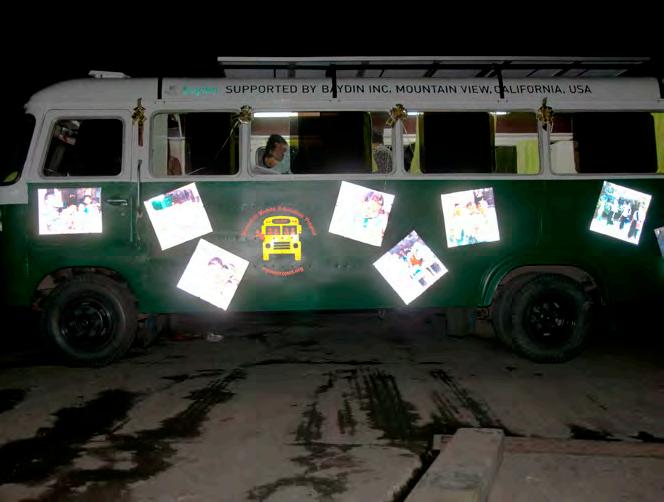
for classrooms—expenses that often present an insurmountable financial obstacle for impoverished households.
Facing tough economic conditions under the former regime, families around the country and especially in rural areas have frequently been forced to send their young boys to cities or towns for jobs in teashops or factories. Many girls also drop out but typically help with chores at home, rather than working at teashops.
This situation has not been greatly alleviated by education reforms initiated under President U Thein Sein since 2011; although his administration has called for free compulsory primary education, offering free textbooks and school supplies to students at the primary level, a lack of income for families means that many children are still required to work.
U Aung Myo Min, a human rights activist and director of Equality Myanmar, says the mobile education
project will not only promote children’s rights, but also hopefully help to identify some of the root causes of child labor in the country.
“The project is an oasis for working children who cannot go to school,” he says, adding, “They should consider a long-term strategy to eliminate child labor. Otherwise, the project will be caught up in an endless cycle.”
Just minutes after one of the buses arrived at a teashop in Yangon on a recent evening, 65 child employees hopped on board. Despite a long day of working as waiters, cooks and tea makers (known locally as a phyaw saya, or brew masters), they seemed enthusiastic about the opportunity to practice writing the English alphabet. Others sat around tables inside the teashop, paying attention to the lesson, and when their teacher pointed at a picture on a whiteboard, the students correctly identified it in unison as a “map.”

“I don’t feel tired. Instead, I am happy because I want to learn,” says Maung Kauk Ya, the 13-year-old son of the toddy palm climber, while completing an in-class exercise on building simple sentences in English. “I’m just grabbing my chance to learn now, because I want to be a university graduate to get a better job.”
 Left: After a day of work, boys at a teashop in Yangon listen to an English lesson by the Myanmar Mobile Education Project.
Left: After a day of work, boys at a teashop in Yangon listen to an English lesson by the Myanmar Mobile Education Project.
There is a reason why peace talks between the government and Myanmar’s ethnic resistance armies are not going anywhere: The two sides are fundamentally at odds over what they hope to achieve.
What the government wants is a “nationwide ceasefire” first, after which it will be up to the individual groups to convert their respective organizations into political parties, contest elections and then, if elected, discuss political issues in Parliament.
The non-Bamar ethnic groups, for their part, want a political dialogue to begin before they sign any nationwide ceasefire agreement. Even more importantly, they see the peace process as the first step towards re-establishing the federal structure Myanmar had before the military seized power in 1962 and abolished the 1947 Constitution.

However, the military—which stands behind the government— sees federalism as a first step toward disintegration of the country, and, therefore, unacceptable. Certain political issues can be discussed in Parliament, but “non-disintegration” of the country is one of six basic principles enshrined in the 2008 Constitution.
On the other hand, the ethnic resistance groups have not articulated their demand for federalism either. What kind of federal union would they want Myanmar to be? How should power be divided between the states and the central government? And what exactly is the “federal army” some of the groups have begun talking
about? Unless those issues have been made clear, there is little or no hope of the military changing its mind about federalism.
Many models have been mentioned: the United States, Canada, Germany, and even multi-ethnic Malaysia. The United States has a federal system, but it is not based on ethnicity, which is what Myanmar’s ethnic groups are demanding. There is no Anglo-Saxon,
Irish, Polish, Mexican, Chinese or Italian state in the US. The states there are purely geographical entities where a multitude of different peoples live.
Canada has a province with a French-speaking majority, Quebec, and the country has two official languages, English and French. In 1999, the predominantly Inuit-speaking parts of the Northwest Territories became a new territory, Nunavut, and there are other autonomous areas in Canada. But, by and large, Canada, like the US, is a country made up of various groups of immigrants and it is not a federal state based on ethnicity.
Malaysia is multi-ethnic, but there is no Malay, Chinese or Indian state in that federation. Malaysia’s federalism is based on the traditional Malay sultanates and some former British colonies and protectorates. But there are different ethnic groups living in all 13 Malaysian states. This is similar to the Federal Republic of Germany, which is made up of old kingdoms and principalities that were united in the late 19th century, except that the
resulting nation-state was, and still is, overwhelmingly German in its ethnic composition.
There are, in fact, very few federations that are—or rather were— based along ethnic or linguistic lines. One was the former Soviet Union, which was dissolved in 1991. Another was Yugoslavia, which fell apart in the 1990s following bitter wars between the country’s different ethnic groups. A third would be Belgium, which has only two major ethnic groups—the Dutch-speaking Flemish people and the French-speaking people of Wallonia— and a smaller German-speaking community in the east. But even with such few ethnic groups, Belgium has had immense problems maintaining its unity, let alone forming functioning central governments.
So are there any successful models Myanmar could follow? There seems to be only one: India. India has 28 states and seven union territories, and although the Indian constitution does not mention “federation” or “federalism,” the basic structure of the
country is federal. India’s constitution has three lists that empower the union and the states to legislate on various matters. For instance, each state has an elected legislative assembly, its own official language and its own police force. But defense is the responsibility of the central government. India has ethnic units in its armed forces, but it is not a “federal army”; it is all under central command. Any other model would be unworkable. The third list contains issues where both the union and the various states can legislate. It is a fine balance, but despite all India’s internal ethnic conflicts, it is working. Unlike the Soviet Union and Yugoslavia, India has not fallen apart, nor is at as dysfunctional as Belgium.
But if Myanmar is going to follow the Indian model, be prepared for all the problems that would entail. There is not a single state or region in Myanmar that has only one ethnic group. There are frictions between Shans and Kachins in Kachin as well as Shan State; the Pa-O rebellion in Myanmar broke out in the 1950s, not against the central government but the dominance of the Shan sawbwas. The United Wa State Army, which is active in northeastern and eastern Shan State, wants a separate state for its people. And while there is a Mon State, the Mon people are perhaps the most assimilated of Myanmar’s many ethnic groups.
Myanmar’s 1947 Constitution, its first, could serve as a basis for discussion, but little more. Its most controversial clause is in Chapter X: The Right of Secession, which said that “every State shall have the right to secede from the Union” after 10 years of independence from British colonial rule. But other clauses stipulate that this right does not apply to Kayin or Kachin states, so it was only Shan State and Kayah State that could, at least in theory, secede from the Union. In any case, the clause was not meant to be exercised, but was put there to make the then proposed Union of Myanmar more palatable for the nonBamar peoples to join. The Mon, Chin and Rakhine states were not established until 1974, and therefore not covered by the 1947 Constitution.
Nor did the new constitution that was adopted in 1974 have any provisions
for federalism or regional autonomy— all that had disappeared after the 1962 military takeover. The 2008 Constitution is not federal in nature either. There is no difference between the states and the regions, and regional and state hluttaws do not have nearly as much power as, for instance, India’s state legislatures or those of non-ethnic federations such as the United States or Canada.
So what could a federal Myanmar look like? When the government embarked on its peace plan in 2009, the ethnic resistance armies were invited to become “border guard forces”—but that was a very ill-conceived idea. Border security in nearly all countries is the responsibility of the central government. In India’s northeastern states, adjacent to Myanmar, border security is in the hands of the paramilitary Assam Rifles, which is under the control of the Ministry of Home Affairs in New Delhi. There are also other centrally controlled border guard forces, and sometimes local police may assist but not be responsible for border security.
On the other hand, Nagaland, Manipur, Mizoram and other Indian states have their own armed police forces that are under the command of their respective state governments. If that system was adopted, the Kachin Independence Army or the Shan State Army could be absorbed into a Kachin State or Shan State Armed Police Force, but not into locally commanded “border guard forces,” which could easily degenerate into bands of border bandits and smugglers.
The Myanmar government and the country’s armed resistance groups need to find a model that works, and the most viable solution would be to study the Indian model. It is also important to remember that when the Shans, the Kachins and the Chins signed the Panglong Agreement with U Aung San on Feb. 12, 1947, it was clearly stated that “full autonomy in internal administration is accepted in principle.” That was the principle upon which an independent Myanmar was founded, and it is still the only solution that would satisfy the aspirations of the country’s non-Bamar ethnic groups.
 Myitkyina, Kachin State, in November 2013.
Myitkyina, Kachin State, in November 2013.
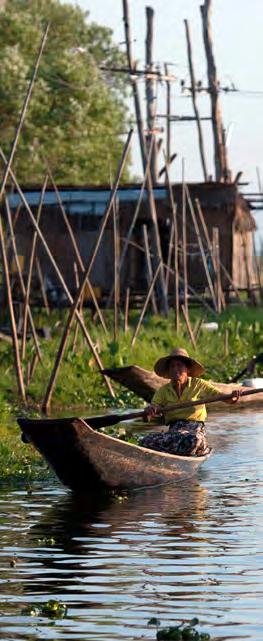
 By KYAW PHYO THA / NYAUNG SHWE TOWNSHIP, Shan State
By KYAW PHYO THA / NYAUNG SHWE TOWNSHIP, Shan State
Gazing out over the vast expanse of Inle Lake, Daw Yin Myo Su remembers the good old days for Myanmar’s second-largest body of fresh water, which is surrounded by misty mountaintops in her native southern Shan State.
As a child she paddled across the lake to visit relatives who, like the other ethnic Intha families that populate the area, lived in wooden houses perched on stilts over the water. During those trips across what is now one of Myanmar’s most famous tourist destinations, she witnessed scenes that no longer exist today.
“Believe it or not, at that time you could drink the water in the middle of the lake when you got thirsty. You could swim. Fish were abundant, and drought in the summer was unheard of,” the 42-year old says. “The situation now is as different as water to oil.”
Speaking from the veranda of the Inthar Heritage House, a center she founded on the lakeshore to preserve Intha cultural traditions, she says the situation on Inle has visibly worsened but is not yet hopeless. “We can still fix up our lake,” she says.
Situated 900 meters above sea level and nestled at the foot of the Shan Hills in Taunggyi District, Inle has long been a popular stop for international tourists, thanks to its iconic leg-rowing fishermen,
floating gardens, stilt houses and biodiversity.
But activists and policymakers say the lake is on the verge of environmental disaster. Sewage and agricultural chemicals have polluted the water and poisoned the fish, while sedimentation has made the 100-square-meter lake shallower. Local population growth and tourism have added to the strain.
The most evident deterioration came in the summer of 2010, when an unprecedented drought in the region dried up much of the lake. The drought resulted from deforestation around the lake and several years of poor rainfall, and it led to severe sedimentation. By April, the vast area of water had shrunk by one-third, turning the vicinity of Phaung Daw Oo Pagoda, a sacred Buddhist pilgrimage site usually accessible by boat, into a virtual wasteland. Villages on the lake were also affected.
“I had to take a motorbike to go to my house because there was no water,” said Buddhist monk U Vijja Nanda of his attempt that year to visit family in Hpa Kone village, where houses had previously been propped up by stilts over the water.
After the drought, the government hastily drafted a five-year conservation plan to reverse environmental degradation and assist local residents. Nearly five years later, UN agencies are offering assistance to develop a new conservation plan, with technical support from Norway.
But today the problem may be more complex.
“A drop in water quality is also a serious issue,” says environmentalist U Aung Kyaw Swar, who is also the principal of a hospitality vocational training center linked with Inthar Heritage House. For two years, the heritage house has collected water samples at five locations around the lake, sending them to laboratories for testing.

“Most of the results show the water is contaminated with a heavy metal like lead that could be cancerous if consumed,” he says, adding that farmers who grow tomatoes and other vegetables on floating gardens use excessive quantities of chemical fertilizers and pesticides to boost yields.

The agricultural practice could devastate the ecosystem of the lake, which boasts 59 species of fish, including 16 that are endemic, according to the Inle Wetland Wildlife Sanctuary.

“They spray it directly on the plants in unregulated amounts,” the environmentalist says. “The agricultural runoff contains chemical pesticides and pollutes the water.”
Population growth has also had ill effects. Most of the more than 100,000 people currently living in homes over the lake and on its edges regularly dump sewage into the water, while small family-run weaving and silversmith businesses allow untreated wastewater to flow.
The lake’s natural filtration system may have managed this issue in the past, but the pollution is now too severe. The Department of Fisheries last year reported that pH levels, a measure of acidity, had risen to between 8.4 and 9.6 at points on the lake, endangering once-abundant native fish species such as the Inle carp (Cyprinus carpiointha, known locally as Nga-phane).
As a result, fisherman U Myo Aung takes home a smaller load these days.
“I only catch about 3 viss [4.8 kg] after spending the entire day on the lake,” the 36-year-old says, compared with bringing in at least 4 or 5 viss on a single morning before the fish began dying out.
On the keel of his wooden boat sits his catch of the day: tilapia, a hardier species that was introduced to the lake because it can withstand the chemicals, but which is reportedly less tasty than the
native Nga-phane.
“I earn just 1,000 kyat [US$1] for one viss of tilapia. They are the only fish I catch, but not in a very large amount,” says the father of four.
Another reason for fish scarcity is the popularity of electric shockers among fishermen. The technique is an effective method for stunning the fish before they are caught, but it also devastates microorganisms in the lake that can improve water quality.
“They use it because they lack other economically viable alternatives,” says U Sein Tun, the park warden of Inle Lake

Daw Yin Myo Su is no Johnny-come-lately to the hospitality industry. As a young girl she performed traditional dances to entertain guests at an inn run by her family in Nyaung Shwe, a town near Inle Lake, and today she is managing director of two resorts: Inle Princess Resort, also near the Shan State lake, as well as Mrauk Oo Princess Resort in Rakhine State.

But Daw Yin Myo Su, also known as Misuu, is a woman of many interests, with a reputation near the lake for founding the Inthar Heritage House, a center dedicated to preserving the ethnic Intha traditions of her ancestors. She is also the winner of the 2013 Goldman Sachs & Fortune Global Women Leaders Award. In a conversation with Irrawaddy senior reporter Kyaw Phyo Tha, she discussed environmental conservation and women’s empowerment, and explained why she believes development should not come at the cost of local culture.
What’s your vision for Inle Lake?

I belong to the Intha tribe and had many sweet childhood memories at Inle Lake, so I’m very proud to come from this simple and warm Inle community. My vision is not that complicated. I believe I inherited the lake from my ancestors, so it’s my responsibility to hand it over to the next generation just as I received it, but with some improvements, like in health and education. I understand nothing lasts forever but I don’t want to give it up without a try.
Now tourists are rushing in. Will this help improve the lake and the lives of local people?
So far it has generally had a positive
impact on Inle people indirectly, by creating jobs as local guides, boat drivers and souvenir sellers. But there are no more than a dozen locally owned hotels and very few successful local entrepreneurs. With tourism booming, I think locals should see a good share of the benefit. If not, in the long term they will feel alienated.
Do you mean you oppose foreign investment or foreign-run hotels?
No, I don’t. You can even learn from them. Instead of seeing them as rivals, we have to compete with them by offering quality services to guests. At the same time, if they want to sustain their businesses, outside investors should take care of the local community. If Inle is no longer attractive to tourists, no one will come—no matter how much you invested. Of course we all need to make money, but you have to contribute to the community. Foreign investors are welcome. Show us a smart way to invest, teach us a smart way to work, be our model. Inspire us. Help us this way, and we will help you. It’s a winwin situation.
How can local businesses stay competitive?
Being a local is part of the brand—it’s valuable. Being a local is attractive for tourists who want to visit our country because they really want to understand who we are or how we live. They don’t come here to see something they can see in other countries. For them, something local is authentic. You have to be creative with your current assets to ensure the comfort of your clients. Plus you need to work as hard as foreigners. Don’t be lazy, especially at this moment when everyone is interested in Myanmar.
What are you doing now?
I’m working on the Inle Heritage Foundation to preserve the tangible and intangible heritage of Inle and its surroundings. I started with breeding Burmese cats at the Inthar Heritage House, and I also have an aquarium that conserves the endemic fish species of Inle Lake. Since last year we have run a hospitality vocational training center at the Inthar Heritage House for local young people, to help the community diversify their livelihoods and get a bigger share in the development of this industry. We are also running pilot projects on good agricultural practices and waste management for the lake.
Why did you go into the hospitality industry?
Hospitality is in every Myanmar person’s DNA. It is taken for granted in Shan State that even a stranger will have a cup of green tea when he drops by at a farmer’s home. I feel great when I make someone happy. I want to help people. If guests tell me during checkout that they were satisfied with our service, I’m on cloud nine! That kind of happiness is beyond expression. Plus I get money from them. Don’t you think it’s good?
Wildlife Sanctuary, who has helped spearhead an education campaign to deter the practice. Last year 40 fishermen were arrested for using the electric shockers.
Whether or not his campaign is successful, other environmentally harmful practices have persisted.
“Activities that negatively impact the health of the lake have not changed,” says Joern Kristensen, director of the Institute for International Development (IID), an Australia-based organization which in 2012 sent a report with recommendations for conservation and sustainable management to the Ministry of Environmental Conservation and Forestry.
“There is still considerable overuse of chemical fertilizer and pesticides negatively impacting the water quality. There is still untreated wastewater being let out into the lake from households and cottage industries, there are still trees being cut down around the lake to provide firewood for cooking, leading to soil erosion, and there is more noise from the growing number of boats on the lake.”
In the 2012 report, the IID called for the formation of a single body to oversee conservation efforts at the lake. In January this year, President U Thein Sein gave his backing to the new Inle Lake Conservation Authority, which will coordinate and monitor all conservation activities, prioritize investments and project funding, and store data about the lake into a shared database.
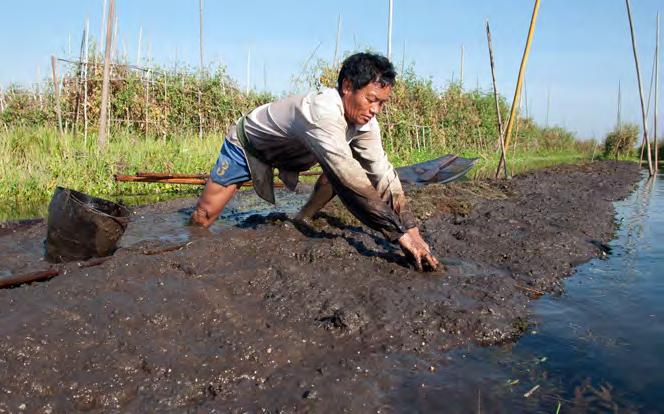

“Everything is connected and needs to be managed in an integrated, holistic manner,” says Mr. Kristensen.
In particular, he says it will be crucial to manage new income–generated in part by increasing tourism–toward projects that help maintain the health of the lake.
“This requires involvement and support by all interested parties, in particular the private sector, which benefits from the opening of Myanmar and has a strong interest in maintaining the lake region as an attractive destination for foreign and international visitors,” he says.
Tourism has boomed over the past three years, with nearly 100,000 visitors heading to Inle Lake in 2013.
“We expect to have more than 150,000 visitors this year,” says U Win Myint, the Intha affairs minister for the Shan State government.
Foreigners must pay a US$10 admission fee to see the lake, and half that money goes toward infrastructure development, while the rest goes to the state government. But the minister says little has been done to invest in the livelihoods of local people, who continue to use chemicals and electric shockers, while also throwing sewage into the water.
“They know what they are doing is bad, but they don’t have economically viable alternatives. This is a problem that still lacks a solution,” he says.
Construction of hotels and an
increase in foreign investment could create jobs, he says, after the government approved a new hotel zone that will cover 662 acres on the lake’s eastern shore.
And if residents living at the lake can take up hospitality jobs, they may find the means to support their families, adds Mr. Kristensen of IID.
“If young people who belong to the region are trained and find employment in the tourism industry, they will be good ambassadors for the lake,” he says, while also laying out a less optimistic alternative: that new jobs go to people from Lower Myanmar who can speak English but do not understand the lake’s cultural and environmental heritage. In that case, he says, “The next generation of farmers will continue unsustainable agriculture.”
In the meantime, the hospitality training center at the Inthar Heritage House is staying busy. All 39 students at the center grew up on the lake and its surroundings. Most received scholarships to the center because they could not afford the tuition fees.
“As tourism booms and job opportunities open up, we are simply meeting the demand for qualified employees who are not only skillful, responsible and caring to guests, but also mindful about improving conditions of their family, Inle Lake and the country,” says U Aung Kyaw Swar, the principal.

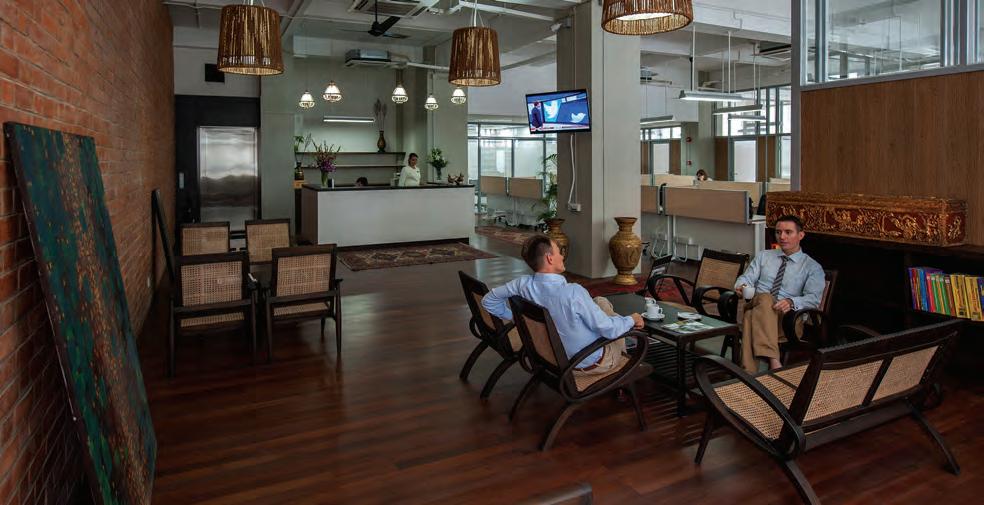
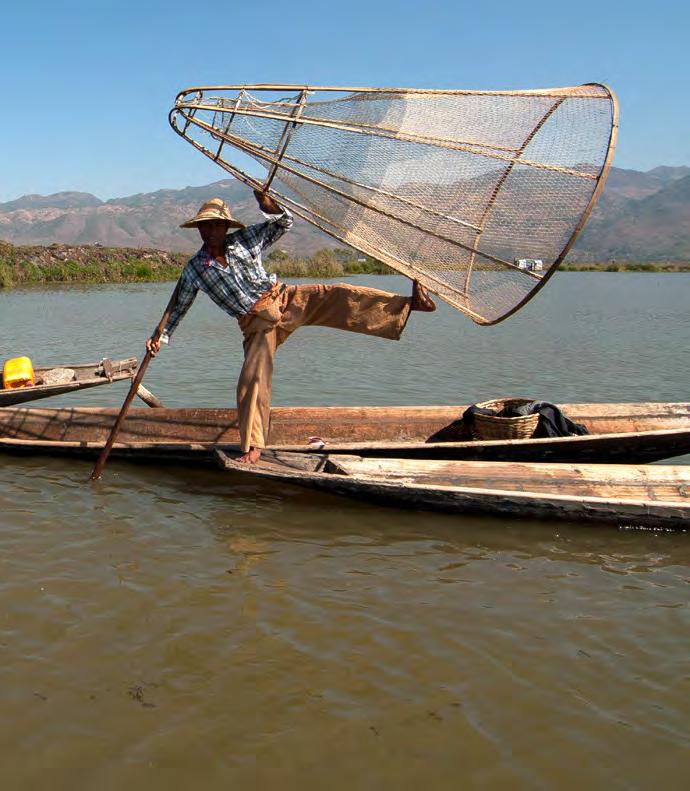

Daw Yin Myo Su, founder of the Inthar Heritage House, also chairs the training center and is now working on pilot projects to promote better agriculture practices and wastewater management systems on the lake.
“I believe if everyone contributes what they can, it’s possible to make a change, no matter how bad the situation is. I just do what I can because I want to hand over the lake to the next generation in the same condition that I received it from my ancestors.”
As Myanmar’s economic opening continues apace, hopes are high for plans to launch the country’s first full-fledged stock exchange in more than 50 years. But while the new bourse looks set to meet a late 2015 deadline, observers say a number of key issues could still present major obstacles.
Last September, the government and Parliament approved the Securities Exchange Law, clearing the way for the creation of the new Yangon Stock Exchange (YSE) in October 2015. Earlier, in May, the Central Bank of Myanmar and Japan’s Tokyo Stock Exchange (TSE) and Daiwa Securities Group had reached an agreement to establish the YSE as the first market of its kind since the economy was nationalized after a military coup in 1962.
Daiwa, a Tokyo-based investment company valued at US$400 billion, has been working in Myanmar since 1996, when it teamed up with state-owned Myanma Economic Bank—which was recently given the go-ahead from Washington to do business with US companies—to create the Myanmar Securities Exchange Center (MSEC).
While the MSEC was largely ignored (in 2011, Reuters reported that it had a staff of eight employees and was trading stocks in just two companies), the YSE promises to provide a viable
alternative to the trade in gold, US dollars, real estate and used cars that for decades were the only places for local business people to put their money in the country’s closed economy.
One consequence of this imbalanced investment was rampant inflation, which has only recently dropped to 6 percent from the 30-40 percent seen in the years prior to the introduction of reforms in 2011. Even now, the real estate market remains overheated, while the relaxation of import duties has seen a dramatic fall in car prices, which reached 100 times their market value between 1988 and 2011.
With the introduction of the YSE— which will be established with a 32 billion kyat ($32 million) investment, including the TSE and Daiwa’s 49 percent stake—the government hopes investors will put their money to more productive use in a variety of sectors and industries, such as services, banking, agriculture and hotels and tourism.
Among those keen to hop on the YSE bandwagon is Asia Green Development (AGD) Bank, owned by U Tay Za, one of the country’s richest tycoons. In December, Daiwa announced an “important milestone of efforts to develop capital markets in Myanmar” when it signed an agreement with the bank to assist it in its bid to be listed on the exchange.
But turning a privately owned bank into a public company won’t be easy, especially in a country that has long been notorious for the opacity of its business practices. AGD Bank is confident, however, that it can make the transition.
“Now we are more transparent—100 percent more—than in the past,” said the bank’s managing director, U Ye Min

Oo. “We have to show all our profits to shareholders annually, and the decision makers have changed. Now we can’t do anything without the approval of the board of directors.”
One decision the board of directors has made is to hold off until the launch of the YSE to start offering shares, in the expectation that the opening of the new stock exchange will boost share


“We are more transparent–100 percent more–than in the past.”–U Ye Min Oo, managing director of AGD Bank PHOTO: SAI ZAW / THE IRRAWADDY
prices. As a company with 30 billion kyat (US$30 million) in capital, AGD Bank can raise up to 70 billion kyat from the sale of shares (the government has set a 100 billion kyat limit on the value of public companies).
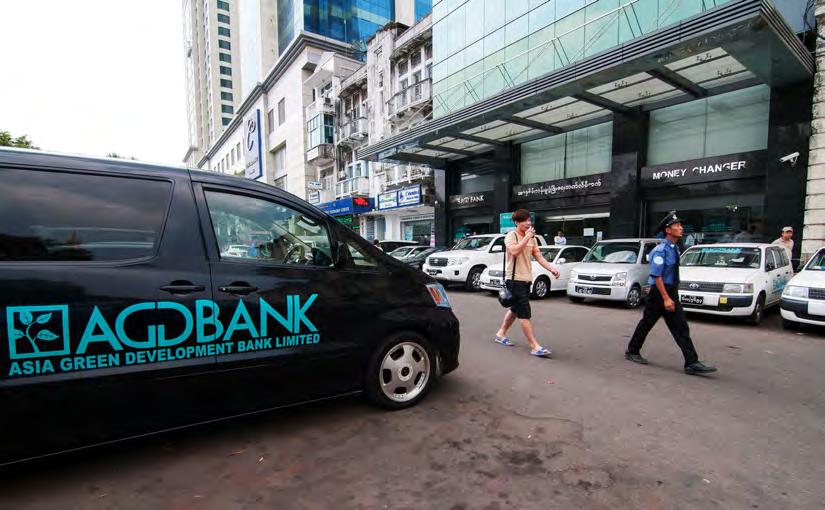
But even if AGD Bank is ready for the big day, many in Myanmar’s business community, noting the lack of reliable telecommunications infrastructure and poor public awareness of how stock markets work, wonder if the country is up to the task of hosting a modern stock exchange.
“We will need constant access to up-to-date information about stock shares, but how can we have that without better communications?” said U Ye Min Oo, echoing these concerns. He added, however, that he expected the situation to improve after two major international telecoms companies that have recently been given licenses to operate in Myanmar—Norway’s Telenor and Ooredoo of Qatar— establish much-needed networks.
Fully aware of the challenges it is facing, Daiwa is taking a cautious approach to its second stab at setting up a stock exchange in Myanmar, with plans to list just 10 companies at the launch of the YSE, according to U Ye Min Oo.
U Thet Htun Oo, the senior manager of the MSEC, said expectations would be modest for the first couple of years of the YSE, until conditions improve and more companies capable of functioning within a more mature trading system emerge.
“It won’t be easy to develop a stock market right away. First, we need to achieve economic stability and reach a certain level of development. Also, the private sector has to improve, and exact laws and regulations will be required,” he said.
Among the problems that will need to be addressed, he said, were most Myanmar companies’ deficient management and accounting systems, their lack of transparency and adequately trained staff, and illegal practices such as fraud and tax evasion.
“We will need collaboration between the government and the private sector, as well as foreign expertise, to tackle these issues,” he said. “I don’t think we have enough time, but we’re trying to work within the government’s timeline.”
In the end, however, he said the development of the stock market would be a boon to the economy. “As the market develops, the country’s economy will also improve. But that
will probably take another five to 10 years,” he said.
U Maw Than, a retired professor who is currently acting as an economic advisor to President U Thein Sein, agreed that the new stock market would face many challenges. However, the most pressing, he said, is the country’s flimsy legal infrastructure.
“Even though there is a new stock exchange law in place, many more rules need to be introduced, such as liaison rules for brokers and dealers, so that the public can participate,” he said.
“Any company that wants to be publicly listed should also be required to disclose who is on their board of directors, as well as information about the past histories of the directors and the companies themselves. When these conditions are met, the public can play a more active role in helping businesses to develop,” he added.
Although the country clearly has some way to go before it is ready to expand the ranks of investors to include a broader cross-section of the general public, the demand for a move in that direction is already evident.
In January, the First Myanmar Investment Co., Ltd. issued an additional 2.5 million new ordinary shares for 10,000 kyat each after selling out an earlier offering of 2,500,000 shares to existing shareholders amid overwhelming demand.
With plans by the Thilawa Special Economic Zone Committee to form a public company and begin selling shares to the public early this year, a modern stock exchange is looking increasingly like an idea whose time has come, whether the country is ready for it or not.
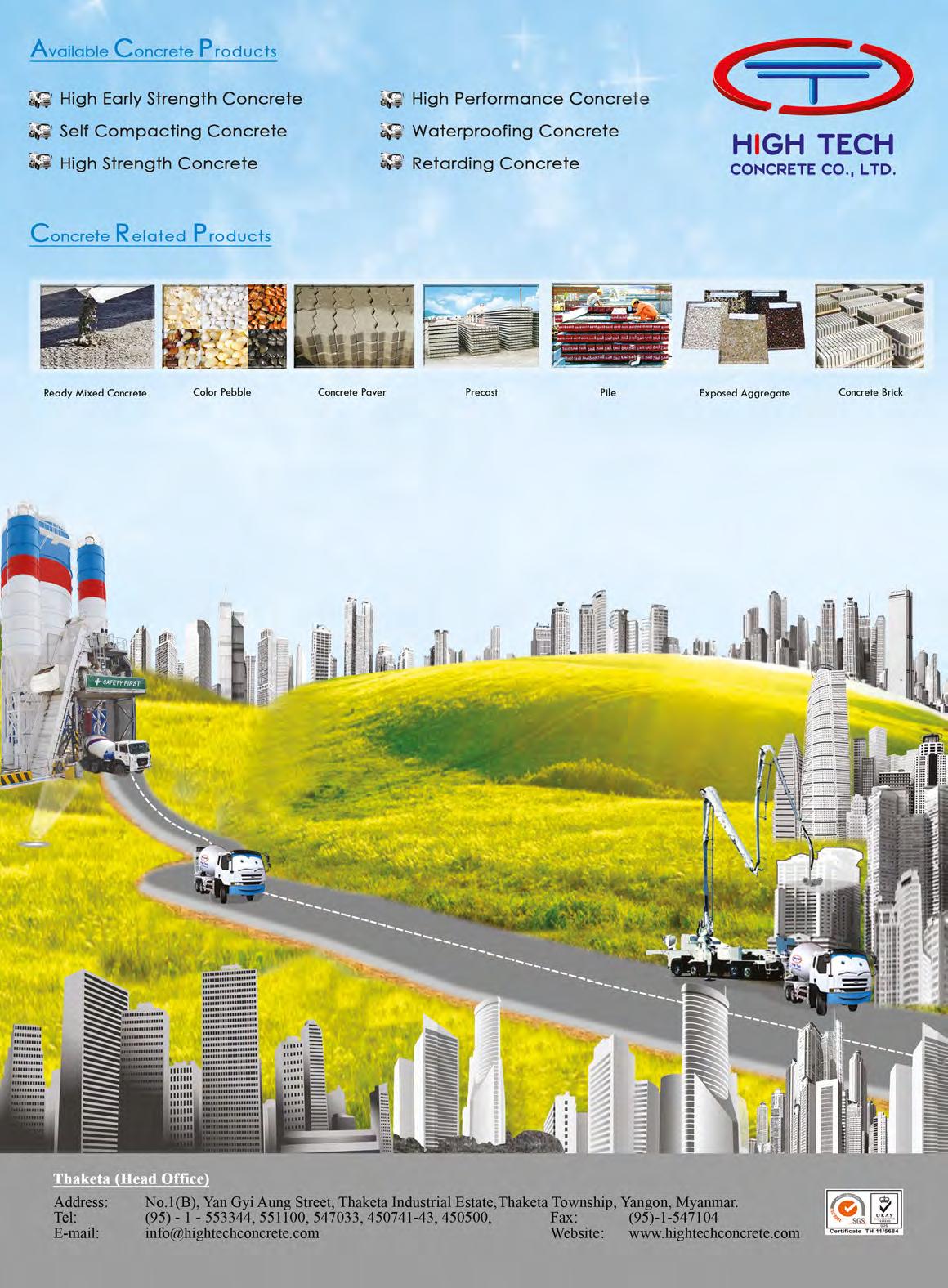
As Myanmar’s leading retailer, City Mart Holdings has made great strides since the opening of its first outlet in the north wing of Bogyoke Aung San Stadium in Yangon in 1996. It now has 15 supermarkets in Yangon, Mandalay and Naypyitaw, and has expanded its business to include a wide variety of other retail stores.
Daw Win Win Tint, 39, has been at the helm of the company since 1997, shortly after she returned to Myanmar with a degree in business management from Singapore. She spoke recently with The Irrawaddy’s Kyaw Hsu Mon about the challenges she has faced as one of the country’s leading woman entrepreneurs.
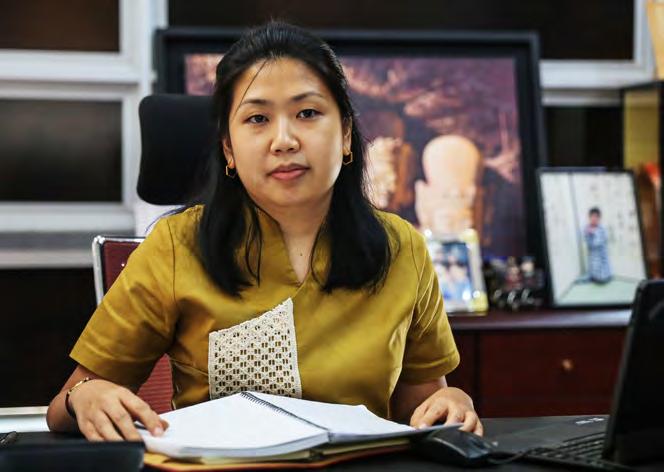
as expensive, so it was difficult to compete with small wholesale shops. But we invested a lot in this style of supermarket, so eventually we were able to gain wider acceptance.
Does that mean that at the time you could only sell to high-end customers?
Well, initially our sales were very poor and we were losing money, but that gradually began to change after we opened in the Junction 8 shopping mall in 1998. After that, our customer base started to expand. We can say that people’s purchasing power is still quite weak here, but that is slowly changing.
Roughly what percentage of the population goes to supermarkets, as opposed to traditional wet markets?
At the moment, only around 10 percent of the people here use modern supermarkets. But we expect that to change as incomes rise.
How have things changed since 1996 for small and medium enterprises (SMEs) in Myanmar?
How many kinds of retail shops do you have under your supervision?
In addition to our 15 supermarkets, we have five Ocean Super Centers, 19 Season Bakeries, three City Baby Clubs, three Popular Book Stores, and many other retail stores. They are all organized as modern retail stores, which is quite rare in Myanmar, where only around 10 percent of retail shops are organized in this way. Most people here are more familiar with shopping malls like Yuzana Plaza, Sein Gay
Har and Super One, whereas we are set up more in the supermarket or hypermarket style.
So was it difficult to win over consumers when you first entered the market?
Actually, we were not the pioneers in this market. There were already a couple of local supermarkets operating here, as well as a Singaporean chain. But when we started out, the biggest challenge was that we were perceived
In 1996, the market economy in Myanmar was still young, so there were a lot of people starting new businesses, even though they didn’t have much knowledge at that time. We were actually a bit late coming into this market, since the economy started opening up in 1992. When we came in, the economy was facing a crisis because the government had changed the import and export law. Then in 2003-4 there was another crisis, the banking crisis. That’s why there are only a few companies that started out when we did that are still around. Now that the government has changed, we’re seeing many more SMEs emerge. But now the amount of capital you need to start a new business is much higher than before.
How much were you affected by the US and EU sanctions imposed in the 2000s?

Well, some of our regular suppliers were no longer able to get certain products because of the sanctions. We relied on small suppliers, so that was really a struggle for us. Also, we had trouble developing our IT services because all of the software came from the West. We couldn’t buy directly from the original developers And there had no direct trade [for other products] between Myanmar and Western countries, so we had to source goods from Thailand or Singapore, which meant a lot of additional costs.
In 2005, there were bomb blasts at two City Mart outlets. How did this affect your business?
We’ve experienced a few crises like this, including the flooding in 2007, in which we lost almost everything at our outlet in the Dagon Center, and during Cyclone Nargis in 2008. But the bombings at the Dagon Center and Junction 8 in 2005 were the worst. At the time, I felt completely helpless. Customers and staff were both injured by the blasts. We did our best, and after closing for a month for renovation, we
reopened. But it took time to win our customers’ trust again. Since then, we have paid serious attention to security issues.
City Mart was recently among a number of businesses that were inspected for illegal liquor imports, even though you are not an importer. What is your reaction to this?

I am satisfied that the government is handling economic reforms well, because we have seen a real improvement in the business environment. However, during this transition period, there are bound to be some mistakes. We just have to let them [the government] know that they need to consider all points of view before they decide to do something. And they should also listen to the advice of economists to improve their trade policy.
Do you face any particular challenges as a woman entrepreneur?
This has never really been an issue for me. Compared to other countries,
Myanmar women have a lot of opportunities. There is almost no discrimination. The real problems I face stem from the unstable trade policy and the lack of coordination among the different government ministries. We never get any assistance from the government. Sometimes I think this lack of assistance has made me more capable as a businesswoman.
What is the secret of City Mart’s success?
From the beginning, our priority has been serving our customers. We are always looking for new ways to offer them better services and quality at a fair price. This makes me confident that we can continue to keep our position as a market leader.
Do you plan to open any new branches this year?
We are going to open some new branches in the 2014 fiscal year. The main challenge we face right now is the skyrocketing price of property, but we will do what we can to continue expanding. We also have to prepare for the influx of foreign investment that we’re expecting after the establishment of the Asean Free Trade Area in 2015.
What should the government do to support local businesses before then?
We need to strengthen our ability to compete, so the government should make it easier for us to get financial backing. We also need access to better locations, and more technical support. Human resources could also be improved.
Do you have concerns about the future?
Competition will be very tough, so we are going to have to work harder. Perhaps the most important thing the government can do to help us succeed—even more than giving loans—is to create a more transparent trade policy.










 By KYAW HSU MON / YANGON
By KYAW HSU MON / YANGON
It has long been the advice passed on to visitors to Myanmar: Bring crisp US dollars, nothing else is accepted here.
But the continuing insistence of money changers that cash is untainted threatens to mar the country’s reputation in spite of economic reforms.
Many ticketing agencies, airlines, small currency exchange shops and private banks’ exchange counters will turn away old or damaged, or even slightly crumpled, dollars. Imperfect currency might be accepted, but often at much lower exchange rates.
The obsession with new currency leaves some visitors bemused.
Journalist U Tin Maung Than recounted that when a friend from the United States visited recently, he tried to buy an air ticket from Yangon to Bagan with old dollar bills. The former editor-in-chief of Thint Bawa magazine said the bills were initially accepted, but the travel agency later tracked U Tin Maung Than down at his home and
asked for newer notes instead.
“They told me the airline did not accept the old dollars,” he said.
“Local banks also refused to take it, and the currency exchange counters do not pay reasonable prices for such old notes. It’s very hard to exchange old notes anywhere in Myanmar, even notes that are just creased.”
U Tin Maung Than said the practice only enhanced the backward image many foreigners have of Myanmar.
“We should question why private banks are not accepting these kind of notes, or who is responsible, it may impact on the country’s image,” he said.
In October 2012, Central Bank Deputy Governor U Win Thaw announced that the bank would accept old notes in a bid to eradicate the practice. But the announcement insisted that damaged bills would be of lower value.
The reluctance to accept dirty dollars dates from before 2011 and recent reforms under the government
of President U Thein Sein, when exchanging Myanmar kyat into any foreign currency was illegal with a few exceptions. The Myanmar government offered tourists its own Foreign Exchange Certificates, or FECs, which were officially equal in value to US dollars, but typically fetched significantly less when exchanged on the black market.
In the early 2000s, when Western economic sanctions against the country began to bite, local banks had difficulty trading dollars outside the country. Most external trade went through Singaporean banks, which demanded crisp bills.
U Than Lwin, vice chairman of Kanbawza Bank, insisted the bank was now accepting anything but seriously damaged dollars.
“We’re accepting old dollars as much as we can, but we have difficulty because we still do not have branches of US banks here. If they set up here, it will be easy to change such old dollars,” he said.
“The Singapore banks we deal with still only want new notes. If they’re old, they pay lower exchange rates.”
U Maw Than, a senior economist and advisor to President U Thein Sein said the Central Bank was responsible for solving the problem, and urged customers to complain if private banks will not accept old foreign currency, or offer reasonable rates for it.
A high-ranking Central Bank official, who would only comment on condition of anonymity, said private banks could accept old currency, and that failure to do so would only disadvantage them in attracting customers.
“The Central Bank of Myanmar has allowed [private banks] to open bank accounts with foreign banks for importexport business. They have electronic accounts, and if cash is accumulating, they can send it to foreign banks,” the official said.
“We don’t tell them not to accept old foreign currency notes, and we are just supervising the Myanmar banking sector so that banks do no harm. The currency exchange issue is a matter of market competition. If a bank won’t accept old notes, customers will go to another bank.”

Last year Japan’s Suzuki Motor Corporation reopened its Yangon factory to build pickup trucks, producing about 100 vehicles per month. The factory had been closed down since 2010.
A new five-star hotel planned for Yangon will help boost much-needed facilities for Myanmar’s burgeoning tourism industry, said travel trade magazine TTR Weekly.
“We are now preparing to export 6,000 tonnes of rice that have already been awarded the tender. Japan is going to buy native paddy strains and Myanmar is now test exporting high-quality rice to European countries,” U Soe Tun said, adding that the exports to Europe are part of a favorable trade scheme.
Mor e than 150,000 acres (60,703 hectares) of land confiscated by the army in recent years is to be returned to its previous holders, according to Deputy Minister of Defense Maj-Gen Kyaw Nyunt in a parliamentary statement.
“There are no more land seizure programs in the armed forces but instead land give-back programs,” he claimed, adding that the army has already returned about 10,000 acres (4,046 hectares) and “partially given back” 26,512 acres (10,729 hectares).
However, these promises come against a background of continuing reports of land seized by military units or businesses linked with the army.
In late January, British Foreign Office Minister Hugo Swire told Parliament ahead of a trip to Myanmar that he intended to discuss the issue of alleged land clearances in Shan State in connection with an army-linked commercial teak logging operation adjacent to a planned hydro dam on the Thanlwin River.
The British Parliament had heard about Shan Human Rights Foundation allegations that villagers in Murng Paeng Township are being used as forced labor by Myanmar soldiers providing security for “military-linked logging operations above the planned Ta Sang Dam.”
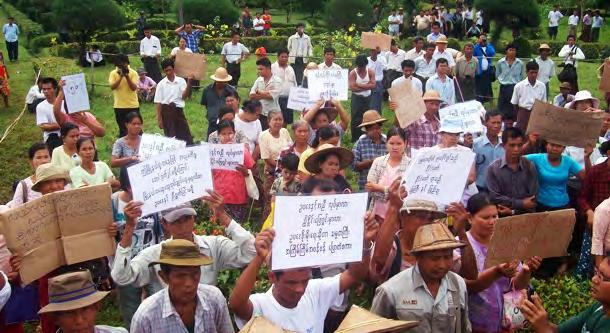
Japanese automaker Nissan is planning to invest more than US$200 million in an assembly factory in Bago Region, according to the company’s official distributor in Myanmar.
U Aye Tun from United Diamond Motor Company, part of Tan Chong Motor Holdings of Malaysia, said that work on the factory, due to be operational by 2015,
will begin once a land tenure agreement is negotiated.
Japanese business news agency Nikkei reported last September that Nissan was planning a production plant in Myanmar.
Nissan plans to “produce several thousand small passenger cars and pickup trucks a year,” said Nikkei. The vehicles will be assembled from parts built in other Nissan factories in the region, including Thailand, it said.
The hotel will be the focal point of a shopping mall plus offices, and will include serviced apartments, said the magazine.
A license to build the complex, details of which have not yet been given, has been awarded to Adventure Myanmar Tour & Incentives Company, “a well-known travel firm based in Yangon,” said TTR Weekly.
The hotel and mall is to be built on land on Shwedagon Pagoda Road in Dagon Township, it said, quoting Yangon’s investment commission.
Myanmar is test-marketing quality rice to European countries as part of an agreement with the European Union, said the Myanmar Agribusiness Public Corporation (MAPCO).
Another batch of quality rice is also being shipped to Japan, said MAPCO director U Soe Tun.
Japan is helping Myanmar’s rice industry to develop new disease-resistant varieties with better crop yield for what MAPCO said was an “emerging market that specializes in top-quality products.”
Myanmar is ripe for investment by Thai businesses in the run up to the creation of a Southeast Asian single market at the end of 2015, the Bangkok government’s ambassador in Yangon said.
“Many other rival countries in the Association of Southeast Asian Nations and Asia, namely South Korea and Japan, are now also eager to invest in Myanmar,” Ambassador Pisanu Suvanajata was quoted by the staterun Thai News Agency (TNA) as saying.
“Thailand should, therefore, have a clear investment direction toward Myanmar so that the country will not be slower than other rival countries in benefiting from investment opportunities,” Mr. Pisanu said.
The Asean Economic Community (AEC) is scheduled to begin towards the end of 2015, after being twice postponed, with the objective of removing trade and labor movement barriers.
“Thailand is also capable in investment areas that Myanmar needs, including infrastructure, construction and other labor-intensive businesses, and service sectors [such as] health, beauty, insurance,” Mr. Pisanu said in an interview.
— WILLIAM BOOT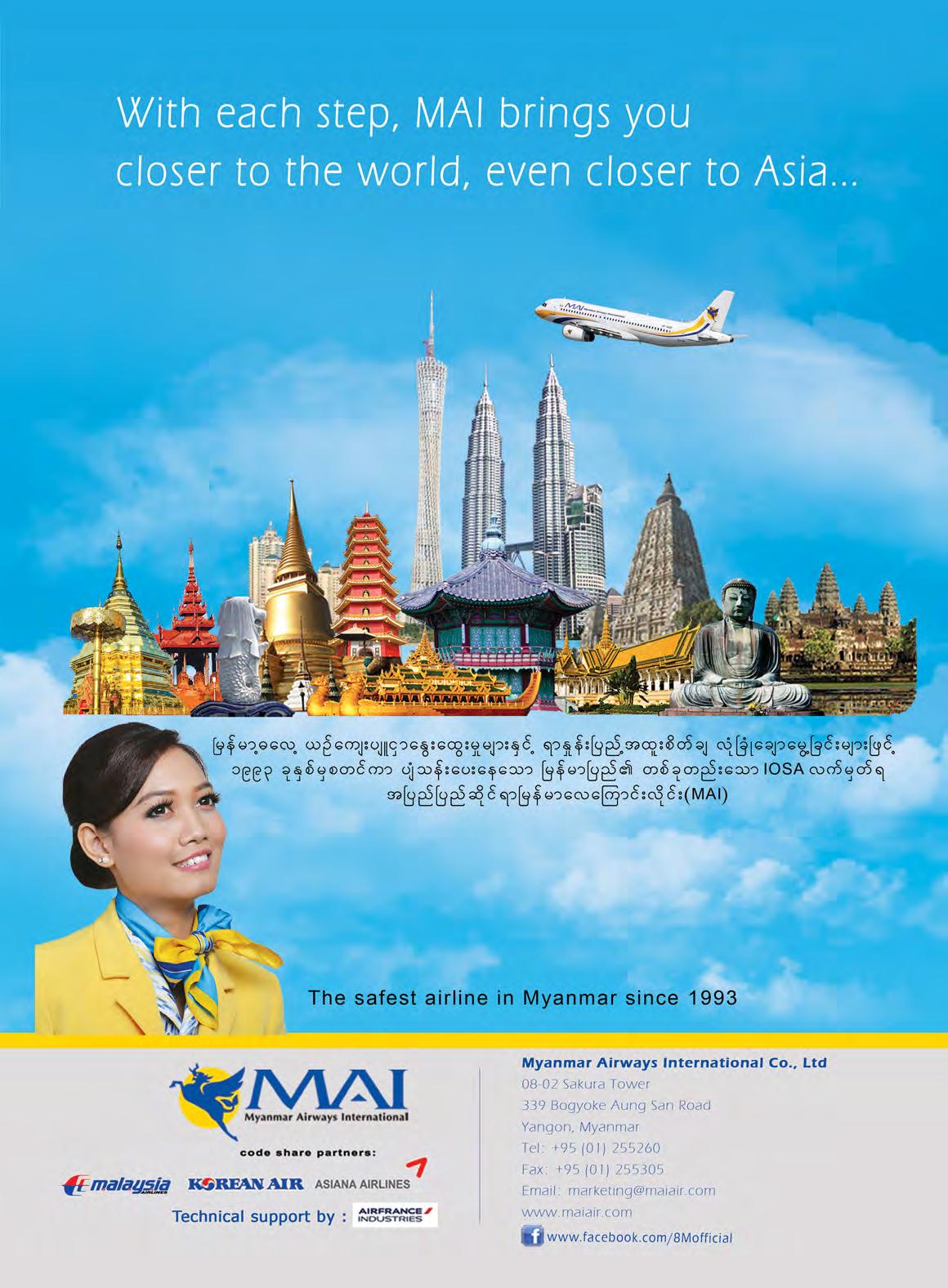
Nguyen Van Tuon seems unconcerned that his business driving Vietnamese gamblers across the border to Cambodian casinos is under threat.
“I’ll believe it when I see it,” said Tuon, waiting in the rain in the suburbs of Ho Chi Minh City for his first fare of the day, when asked about the prospect
that Vietnam could soon allow its citizens to gamble at home.
“It’ll make everyone even more in debt and create more social problems, so I can’t see it happening.”
His confidence may be misplaced. Despite its rigid stance on social order, the Communist government and Vietnam’s top tycoons are exploring ways to profit from what’s currently
illegal, while creating jobs and boosting tourism and tax revenue.
The government could soon legalize domestic casinos to lure billions of dollars of investment from major gaming firms, according to two sources with close knowledge of affairs of the National Assembly, which is due to debate the issue.
The sources, who requested anonymity, said the government had already undertaken research and was planning a pilot project that allows local punters to gamble, starting at a yetto-be built casino on Van Don Island near China.
Vietnamese are passionate gamblers, from clandestine card games to bets on European soccer with underground bookies, but the handful of casinos operating in the country now are strictly foreigners-only.
A change in legislation could make Vietnam an attractive bet for big gaming companies such as Las Vegas Sands, Genting Bhd, NagaCorp and Penn National Gaming, which have quietly expressed interest, should locals be allowed to take part.
The appeal is much to do with Vietnam’s location, just a few hours from many Asian capitals and within easy reach of wealthy Chinese, who provide the lion’s share of gaming revenue.
But Vietnam also has appealing demographics. Twothirds of the country’s fastgrowing population of 90 million are under the age of 30, and it has a consumer middle class that’s expected to double by 2020, according to a recent report by the Boston Consulting Group.
Industry executives say that if it does loosen laws on gambling, Vietnam could become a regional casino hub, with the potential to make annual gaming revenues of US$3 billion. That’s about half of Singapore’s 2013 revenue but 10 times that of Cambodia and on par with the Philippines and South Korea, according to official and company data.
Augustine Ha Ton Vinh, an academic who says he is advising the

government on liberalizing Vietnam’s gaming industry, estimates the country is losing as much as $800 million a year in tax revenue from Vietnamese who gamble in Cambodia.
“The government is looking for investors and partners to start the Van Don project,” he said on the sidelines of a forum in Hong Kong. “Since 2003, Vietnam has allowed foreign investors to operate gaming parlors with rewards in hotels. Chinese and Taiwanese are regular players.”
The extra revenue would be a welcome boost as the economy, once seen as Asia’s new emerging market star, is underperforming with growth of about 5 percent, while high levels of bad debt have hurt the retail sector and regional competition for foreign investment is heating up.
The government has proposed a draft law to the National Assembly on casinos that would require foreign gaming companies with a minimum of 10 years’ experience in the industry to commit to investments of no less than $4 billion.
The planned Van Don Casino, where the pilot project could be implemented, is highly ambitious, valued according to local government at $7.5 billion, a sizeable sum that suggests its target customer is not just the foreign punter.
The project is being spearheaded by Vietnamese billionaire Dao Hong Tuyen and a barely known US firm, ISC Corporation, which plans to build casinos, marinas, a convention center and golf and tennis clubs on the island.
If the pilot scheme is put to a house vote, it is almost certain to pass given the Communist Party’s control of the legislature.
Vietnam’s record with casinos has been patchy, however, plagued by delays, cancelled contracts, poor infrastructure and funding problems.
Envisioned as Vietnam’s landmark casino project, Ho Tram, about two hours by car from the commercial capital Ho Chi Minh City, sits on 164-hectares of pristine coastline. Its operator, Vancouver-based Asian Coast Development Limited (ACDL), has a license to invest $4.2 billion in a luxury resort casino with 541 rooms, 90 card tables and 600 slot machines.
But MGM Resorts terminated its management contract prior to the opening in 2013 and Pinnacle Entertainment, which has a stake in ACDL, was forced to write off $25 million due to delays.
The second of Vietnam’s two big casinos, at South Hoi An, is also stalled, with asset management firm VinaCapital trying to resuscitate a $4 billion project, but yet to name an international partner after Genting pulled out in 2012.
Five smaller ventures are enjoying some success.
The Lao Cai Casino, bordering China’s southern Yunnan Province, operates just eight gaming tables and 34 hotel rooms and caters solely to Chinese punters.
Ben Reichel, executive director of Donaco, which runs the resort, said junket operators on the Chinese mainland extend credit to its highrollers, who bring to the baccarat tables a minimum of 600,000 yuan ($99,000) each.
But while smaller investments can be very profitable, their owners say larger properties that require significant capital expenditure are a more difficult prospect.
“Returns are hard to generate in a short space of time, if at all, in the absence of proximity to market and local play on a large scale,” said Mike Bolsover, chief executive of Silver Heritage, which runs a six gaming table
casino 25 miles (40 km) outside the capital Hanoi.

Bigger casino players say they are watching Vietnam closely, but won’t be betting on a change in law just yet.
US billionaire Sheldon Adelson, CEO of Las Vegas Sands, visited Vietnam three times in the past two years with a view to building casinos in Hanoi and Ho Chi Minh City, but only if the conditions were right.
MGM Resorts, which pulled out of the Ho Tram venture, was monitoring Vietnam in case “a future development opportunity presents itself,” while a Genting executive said it would not invest in any Vietnamese casino unless laws prohibiting locals from taking part were eased.
Timothy McNally, chairman of NagaCorp, said his firm would welcome any move to legalize gambling in what was a “very significant country.”
For some Vietnamese punters, who represent half of the total visitors to Cambodia’s casinos, a change in the law seems a more likely prospect than a change in their luck.
“It’ll be a lot more convenient, it’ll save me time and money,” said one gambler, munching on a baguette and sipping sweet coffee while waiting for his car ride to Cambodia. “It doesn’t matter where I gamble, I always seem to lose anyway.” —Reuters
 By KYAW PHYO THA / PINDAYA, Shan State
By KYAW PHYO THA / PINDAYA, Shan State
Shan State has no shortage of attractions, but few can offer the unusual sights you are likely to behold during a trip into the depths of a limestone mountain near the southern town of Pindaya.
The Pindaya Caves are not so much a natural wonder as an intriguing pilgrimage site, where you can see thousands of Buddhist statues that have accumulated since the spot first became a place of worship sometime in the 18th century.
When you enter the main cave (there are three altogether, although one is only open for religious holidays), don’t be surprised to see a pair of sweating Buddha images. For some reason, moisture only appears on these two statues, making them especially popular with pilgrims, who compete with each other for a chance to wipe away the “perspiration” that constantly covers them. They do this because they genuinely believe this act ensures that their wishes will soon be granted.
As you come close to the end of the 490-foot walking tour of the cave,
you will also witness another remarkable sight: Buddhist devotees enthusiastically collecting clay under a signpost that reads “Black Clay Hillock.” The reason for this is that this is the only place in the Pindaya area where the earth is black instead of red. The devout take this as a sign that the clay is sacred and can be used to ward off evil spirits.
“It’s very hard to explain,” says U Khin Maung Oo, president of the caves’ board of trustees. “Some people claim that their wishes have been fulfilled, so they just keep coming back for more.”
Even if you don’t believe in the magical properties of sacred sweat and soil, you are sure to be amazed by the sheer number and variety of Buddha images in the cave, which is officially known as the Shwe U Min (“Golden Cave”) Pagoda. According to U Khin Maung Oo, who conducted a survey in 2006, the cave contains nearly 7,000 Buddha statues, although other estimates put the number at more than 8,000. They come in every imaginable size, and are made from many different materials, including marble, lacquer and wood. One thing they have in common is that
Previous page: The cave is home to some 7,000 Buddha statues.

Above: The area around the cave entrance. Left and below: The extraordinary array of images provide a singular spectacle.
almost all are covered in gold leaf, applied to them by thousands of worshippers.
Inside the cave, you will constantly feel the watchful gaze of the Buddha, whether you are navigating the maze of statues, sitting under huge stalactites, or carefully making your way along narrow stairs or a terrace dampened by water droplets dripping from rock crevices.


The cave can be visited at any time of year except the rainy season, but if possible, it’s best to come this month, March, when the pagoda’s trustees hold a six-day festival (March 11 – 16) that is one of the largest in the state.
Tourists who visit at this time can check out the festival’s famous mile-long market and watch traditional Myanmar dance troupes performing under centuries-old banyan trees in the pagoda compound. Early visitors will also have a chance to experience the culture of the Danu, the main ethnic group in this area, who give traditional music and dance performances, but only on the eve of the full-moon day of March.
 BY NYEIN NYEIN / NGWE SAUNG, Ayeyarwady Region
BY NYEIN NYEIN / NGWE SAUNG, Ayeyarwady Region
Afive-hour drive from Yangon, the west coast’s Ngwe Saung beach is not exactly a quick getaway, but the reward at journey’s end is still miles of unspoiled sands, wonderful views and crystal waters.

Ngwe Saung remains much more low-key than Chaung Tha to the north. It is not a place for nightlife, except that which you invent yourself; this is a place where quiet continues to reign.
For sustenance, visitors generally rely on hotel food, much of it in beachfront restaurants. There are no independent restaurants on the beach yet. Or you can try the local eateries at nearby Ngwe Saung town, about a five or ten minute drive from most hotels. Thida San restaurant on Myoma Road serves a variety of seafood and Myanmar and Chinese cuisine.
I also enjoyed the other alternative— getting to know the area’s informal vendors, and the fresh fare they provide.
You can meet enterprising villagers and sellers who visit the beach and hotel-side areas with their wares mainly in the mornings and evenings, offering a wide range of seriously tasty local cuisine, including the soups, ngapi, (spicy fish paste) and tosaya (boiled
vegetables) that Myanmar people like to have with virtually every meal.
Fresh from the sea, there’s cooked shrimp, octopus, crab and mussels as well as seaweed salads on offer.
The vendors think of everything. Some have business cards, so you can phone in your order, and some, like Ko Soe Naing and Ma Aye Aye San (tel: 09 2505 98733) will help you with everything you need for an evening campfire meal under the stars, including the food, plates and utensils, and even setting up the fire.
As Ko Soe Naing helped our group with our dinner on the sands, I found out that he began traveling to survive and work after losing his
restaurant business during Cyclone Nargis in 2008. For a time he was in Meiktila, and then Chaungtha, before he came to try his luck at this spot about two years ago.
Ngwe Saung beach has around 18 hotels at a wide range of standards and prices. The cheapest go for around 35,000-50,000 kyat (US$3550), while the most expensive are 100,000 kyat ($100) and up, per standard room.

High-end choices include The Bay of Bengal Resort, the Myanmar Treasure Resort and Sunny Paradise Resort.

For those on a budget, the Yamonar Oo has garnered good reviews. The Yuzana Resort Hotel, once said to have been the area’s top hotel, has lost much of its sheen. But it’s still clean, has superb views, and friendly staff, some of whom speak good English. Rooms come with air-con, a slightly old TV, and Western-style bathroom.
But Myanmar visitors be warned: Should you ask for “foreigner food”—i.e., bread—you may be charged an extra 1,000 kyat.
Also on the downside, the electricity generator is only turned on from between 6 pm and 6 am and there is no swimming pool.
But the ocean at Ngwe Saung is lovely for swimming, and hotels post safety signs indicating where it is advisable to take care in the sea.
Other activities for visitors include renting a bicycle (about 1,000 kyat an hour) or a motorbike (fees vary according to the distance you expect to travel). Or you could go for a gentle horse ride, costing about 2,000 kyat for a kilometer or so.
Souvenir hunters can find stalls selling simple items such as t-shirts, key chains made from shells, purses and photo albums made from bamboo in Ngwe Saung beach and along the coastline near Lovers’ Island.
The little island is very close to the seashore and has great views. Just south of it is the Ngwe Saung Yacht Club, where Myanmar hosted part of the Southeast Asia Games in December last year.
Getting there: Ngwe Saung is about a five-hour drive from Yangon via Pathein, the capital of Ayeyarwady Division. The 30-mile last stretch from Pathein is a twisty mountain road with a peaceful rural feel and views of rubber plantations. Yangon bus companies offer coach trips for around 9,000 kyat.
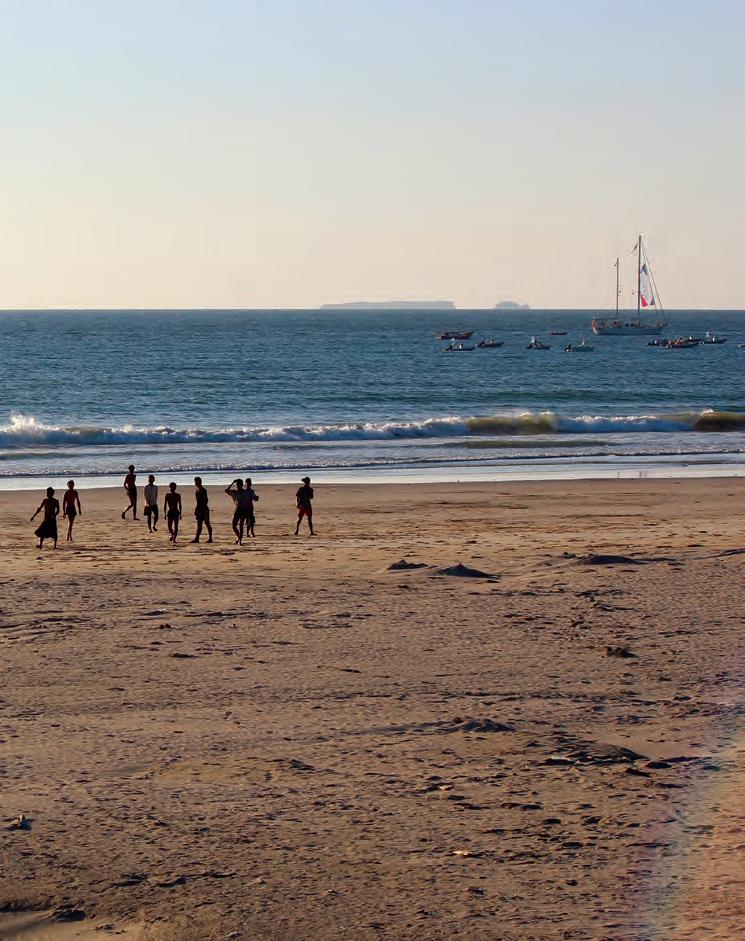
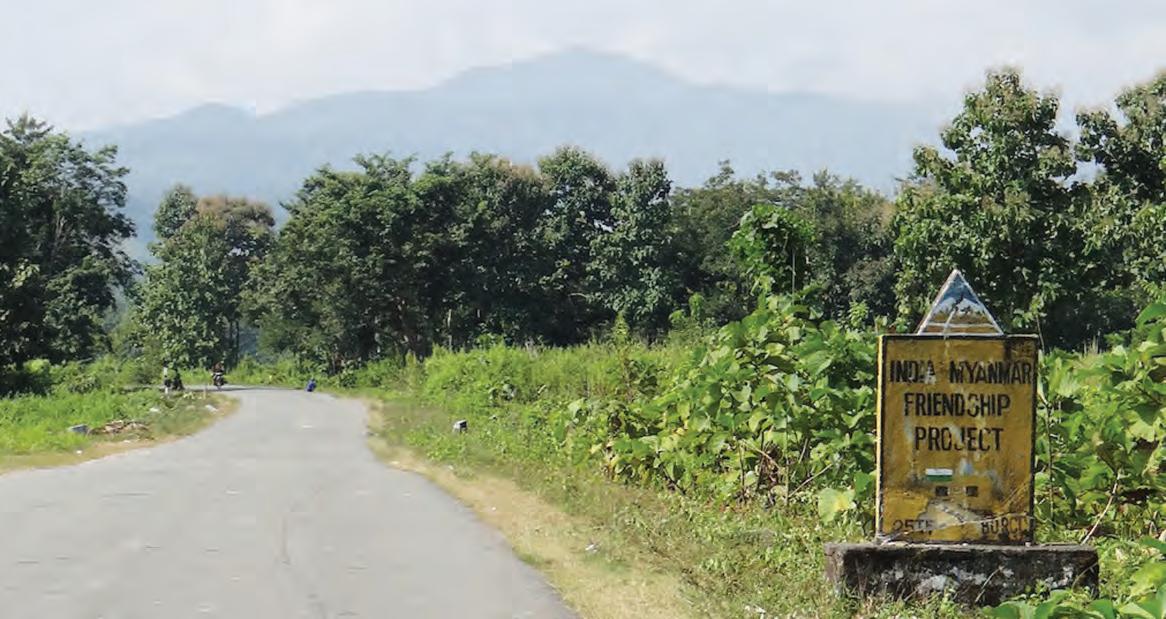
 By EMILIE RÖELL / YANGON
By EMILIE RÖELL / YANGON
After a long and thorough inspection of our documents and various exchanges with colleagues in Naypyitaw, the whitesuited immigration officer finally laid down the phone, broke into a huge smile, and said: “Welcome to Myanmar. We have been expecting you.”
Thus we concluded hours of waiting, first on the Indian side of the border at the town of Moreh, and then
in Tamu town on the Myanmar side. Our hearts jumped. We had just been allowed to cross overland from India into Myanmar independently, and were probably the first foreigners to do so in decades!
We had been traveling for six weeks, setting out from Delhi on a classic Indian-built Royal Enfield motorcycle, to ride more than 4,300 miles (7,000 km) across Uttar Pradesh, Nepal, West Bengal and Sikkim, Bhutan and India’s Northeastern States of Assam, Nagaland
and Manipur towards our ultimate destination, Yangon. We were carrying a by now crumpled official letter from the Myanmar government granting us and the motorcycle permission to cross, but had not been sure it would convince the border officials.
For many days, our speculations on what we would encounter at the Indo -Myanmar border had run high. We were also very curious about the situation in India’s restive Northeast and what our trip might tell us about present and future Myanmar-India relations.
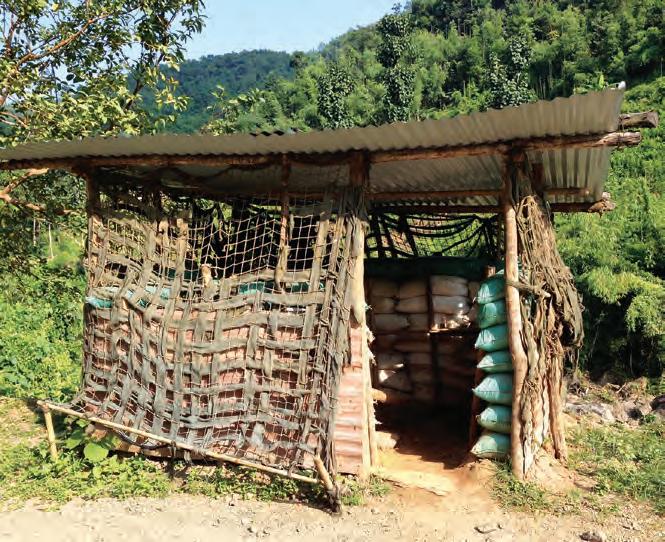

During colonial rule, the British security perception, her policy of frontier management, and, above all, her imperial interest did not allow local economic potential to grow across the border. And the security perception of post-colonial India and Myanmar has treated the borders as vulnerable peripheries. While there has long been informal cross-border trade and movement of people, generally the border at Moreh, in Manipur State and Tamu, in Sagaing Region, has been characterized by an absence of intensive trading and cross-border economic cooperation.
But lately this border point has started to feature prominently on the agenda of diplomatic talks between India and Myanmar. Officials in both
countries now herald the future “gateway” between India and the Association of Southeast Asian Nations (Asean).
However, when we arrived there, we found that there is still little to show for this promising future.
We set out from Imphal, the capital of Manipur State, for Moreh on a road on which we were mostly alone except for a trickle of trucks returning from border shopping. Regular road signs warned travelers not to “pay money to anyone in uniform or UG [underground] groups.”
We had still not gotten used to the ubiquity of soldiers, guns and tanks in this remote part of India, which used to be made up of autonomous kingdoms or chiefdoms, some of which lasted until after the departure of the British.
Resenting becoming a part of India after independence, a “mainland” they culturally felt and continue to feel little connection with, the region has as many as 30 armed ethnic minority insurgent organizations. Their demands range from secession to political autonomy and the right to self-determination. Internal fracturing among the insurgents and dubious performance by the Assam Rifles battalions that have long been deployed to bring security to the region, add to the
troubles.
On the way towards the border we passed various check posts manned by these Assam Rifles regiments, and a couple of times we were waved down and asked what we were doing riding towards a closed border. Our crumpled official letter and elaborate explanations, as well as the granting of requests for a group photo with our camera, were just enough each time to be allowed to continue.
And so we finally arrived at what turned out to be a small outpost of dusty streets, a handful of shops, and an unusual range of prayer houses, which included a synagogue, a church, a Buddhist pagoda, a Hindu temple, a gurdwara and a mosque.
A surprisingly small number of people were out on the streets. Moreh turned out to be a far cry from the bustling towns we had encountered at the borders between India and Nepal and Bhutan.
Proceeding towards the actual border, we were intercepted by members of the local constabulary, who, like the soldiers earlier, were in disbelief that our letter would actually get us into Myanmar. After some debating, the commander agreed to send two men to the Myanmar border to check, and while we waited for their return he complained how difficult relations with the Myanmar officials
on the other side are, since few speak much Hindi or English. He also expressed dissatisfaction with Myanmar’s lack of cooperation in matters of border security.
Soon the commander’s men reappeared with positive news and we immediately rushed onwards. Passing customs, we noticed the basic facilities in place. While India laments the border’s porousness, even at this inspection point screening and detection machines were lacking, and the villagers that crossed along with us under the Free Movement Regime—allowing the tribes residing along the border to travel 10 miles across the boundary without visa restrictions— were not checked at all.
For us, another snap with the customs officer did the trick and soon we found ourselves swerving over to the right side of the road, approaching the Myanmar immigration office that would warmly welcome us an hour later.
Celebrating the successful crossover later that evening, we went for a few beers in a little beer garden and got into conversation with a few young men. They were Myanmar citizens of Nepali origin and were also students of English on the Indian side. They were keen to tell us about their student cards that allowed them to travel around India, and about the bustling cities and celebrations they visited there.
Likewise, throughout India’s Northeast many people had told us how much they would like to visit Myanmar. Some were keen to go shopping in places like Mandalay and Yangon. Others wanted to explore the country and its cultures. Some mentioned with enthusiasm the new air route Golden Myanmar is operating between Imphal and Mandalay.
Strolling around Tamu market the next day, there seemed to be a bit more going on than in Moreh. The streets were wider, and we found larger shops selling Myanmar, Chinese and Thai products. Talking with shopkeepers, we learned that India’s exports mainly consist of agricultural food items like
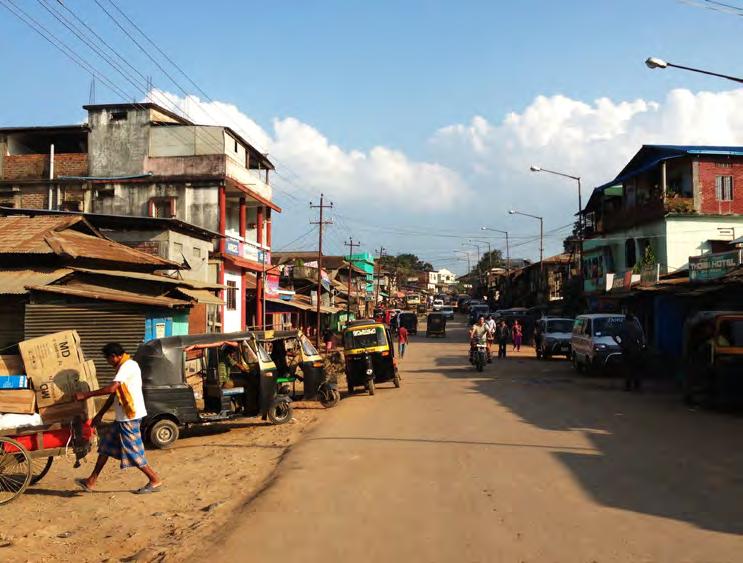
edible buffalo offal, soya bari, skimmed milk powder, soya grid and wheat flour. Imports from Myanmar are made up of agricultural and forest produce like betel nut, dry ginger, serpentine root, and timber, as well as Chinese and Thai manufactured goods.
Later that day, we set out for Kalewa, to the southeast in Sagaing Region. “YOU are travelling on IndiaMyanmar Friendship Road,” read a signboard on the 100-mile (160 km) Tamu-Kalewa-Kalemyo road put up by the builders of the road, the Indian Army’s Border Roads Organization.

Other than that, all traces of India quickly disappeared.
Tamu may well be heralded as the future overland gateway between India and Southeast Asia, but today it remains an isolated frontier. While there is curiosity on both sides, it appears that misunderstanding and suspicion continue to rule relations between the local authorities. Little progress has been made in simplifying cross-border trade, and a long-awaited bus line connecting Imphal and Mandalay remains postponed. As for so many things in Myanmar’s future, the development of Tamu town remains a subject of speculation.

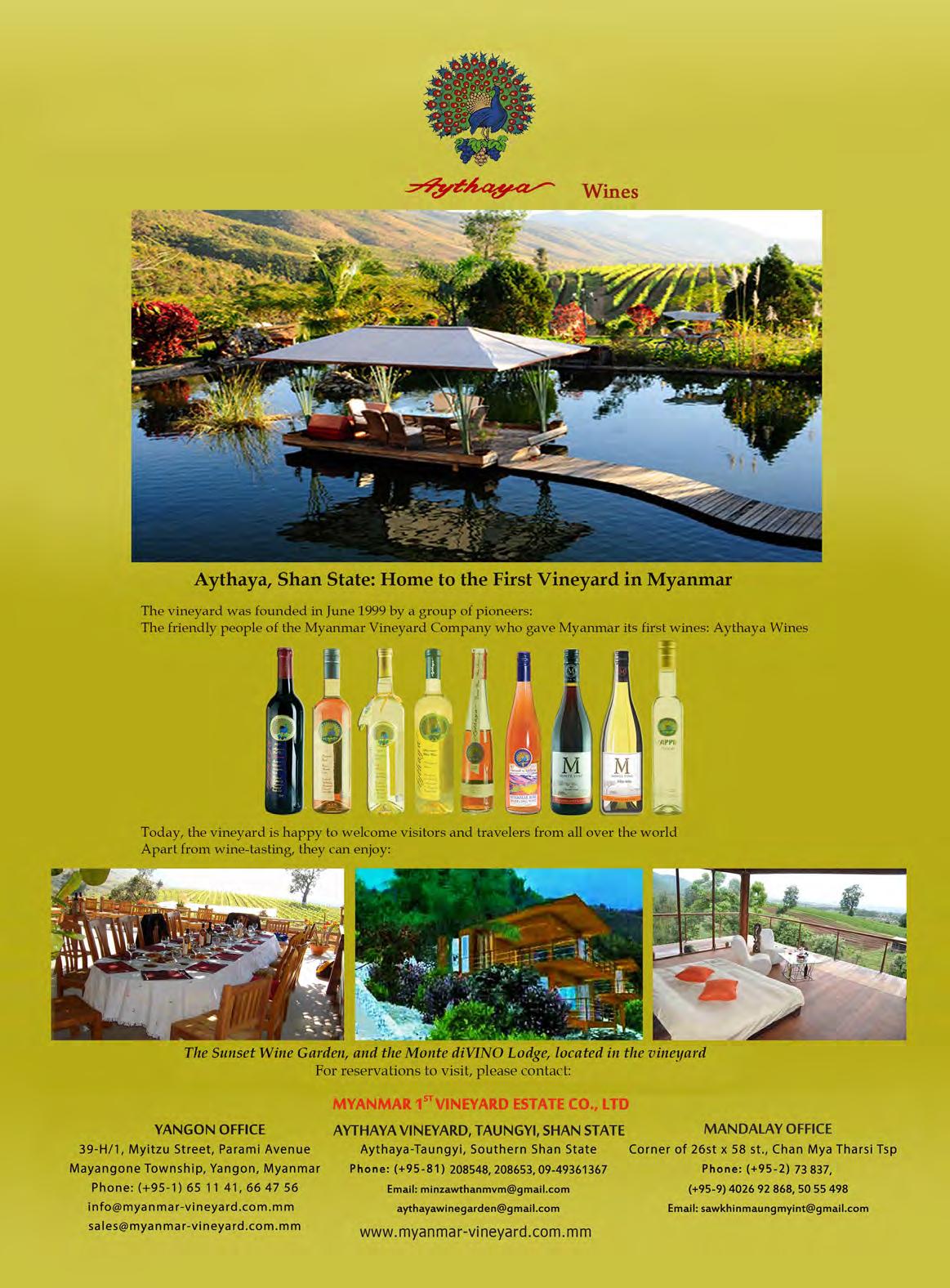
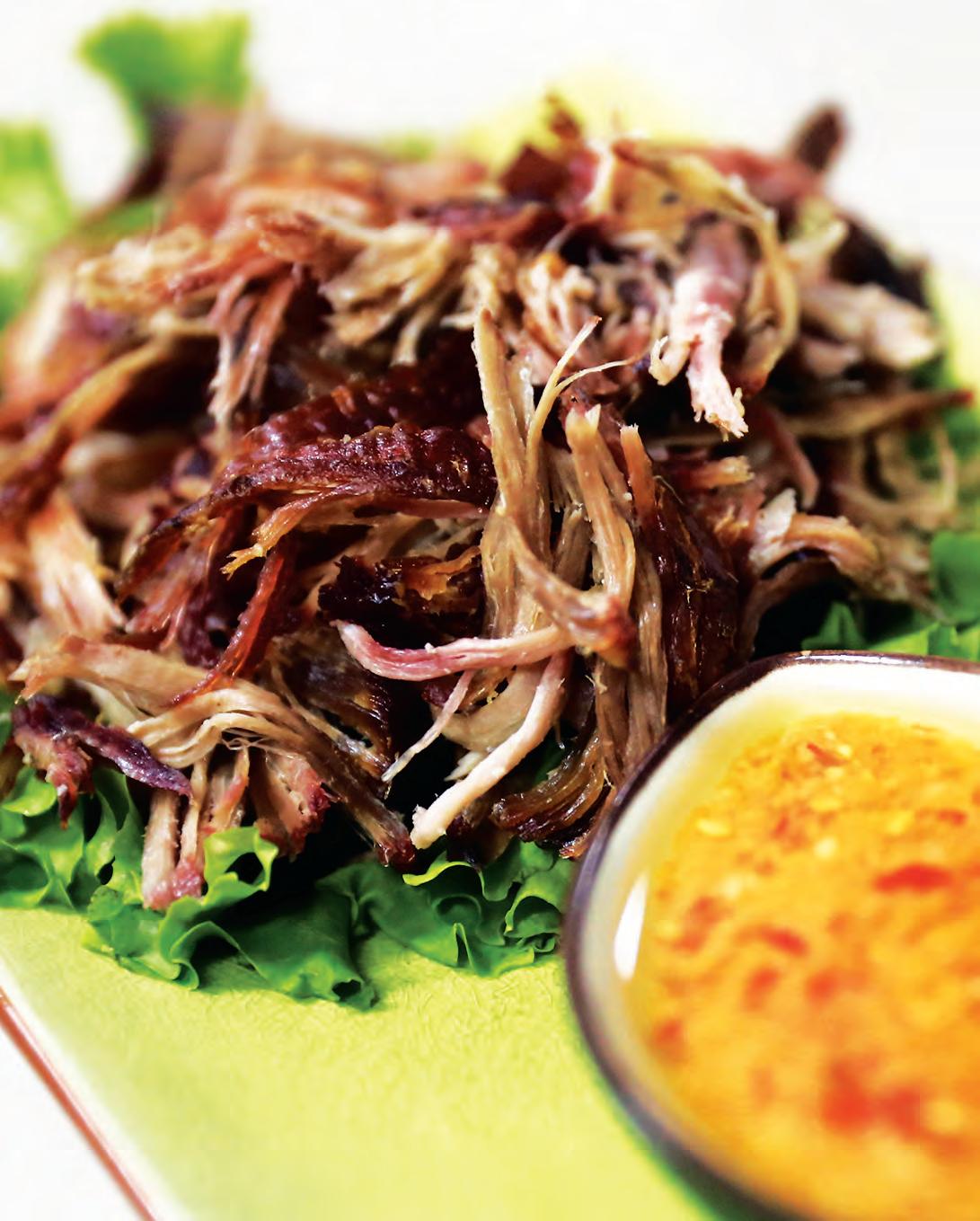
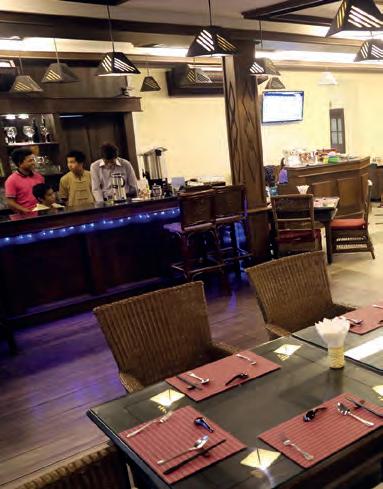 By GRACE HARRISON / YANGON
By GRACE HARRISON / YANGON
Billed as “the first Shanstyle fine dining restaurant in Myanmar,” Shan Yoe Yar, owned by the Asian Sun Group of companies, is part of the growing wave of investment in Yangon’s restaurant industry. Opened in June 2013, this popular eatery produces tasty, attractively presented fare.
“The food is authentic here. You can get Shan tofu and noodles outside, but here is the real cuisine,” says Sai Htun Myo Thant, the restaurant’s director, an ethnic Shan who hails
from Taunggyi but is a long-time resident of Yangon. “Everything is authentic. You can still get noodles, but there’s much more to Shan cuisine. And it’s healthy, not oily food.”
Sai Htun Myo Thant gained his restaurant experience working in Japan, and from 2002 to 2007, he ran a Japanese restaurant called The Planet on Bo Aung Kyaw Street. Now, with Shan Yoe Yar, he is returning to his roots and hoping to win a wider appreciation for his native cuisine.
As director, his main task is
overseeing the entire operation. Occasionally, however, he will also get very hands-on in the kitchen. “I’m sometimes the chef, when I feel like it,” he says.
The kitchen, spread over two floors, is unusual in its design. Hot meals are cooked on the ground floor, while soup, salads and appetizers are prepared upstairs. Surrounded by plate-glass windows, the modern kitchen stands in striking contrast to the traditional architecture of the rest of the building, itself heavily renovated with new wood.
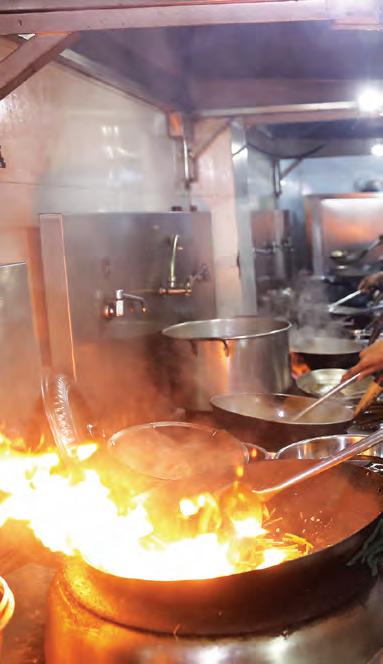
“The old house was always here. There used to be seven colonial villas occupying this whole stretch of the road. Here we kept the frame and transformed the inside into a Shan-style restaurant. The managing director wanted it to become like a Shan palace. We took inspiration from those places,” explains Daw Ingyin Zaw, the restaurant’s business development manager.
Upstairs, there are four private rooms themed according to different parts of Shan State and decorated with black-and-white photos of famous people and places—including, of course, pictures of Sao Shwe Theik, the first president of Myanmar and last Saopha of Yawnghwe (Nyaung Shwe). A central hall connects the rooms, which are perfect for meetings, workshops and celebrations.
Downstairs is clean and comfortable, but decidedly less cozy, with bright fluorescent lighting, strong air-conditioning and two large TVs for entertainment.
Wa Dan St, Lanmadaw Township Tel: 01-221524, Email: shanyoeyarfoods@gmail.com
Open Monday to Sunday, 6 am -10 pm
Shan food is known to be less oily than other cuisines in Myanmar, making it an enjoyable alternative to the standard local fare. For 10,000 kyat, the vegetarian set—consisting of stir-fried okra, a delicious eggplant soup, stir-fried mixed vegetables, cute potato croquettes, and crispy fried leek root, served with rice, coffee and fruit—will leave you with a satisfied, “clean” feeling at the end.
Other specialties include a traditional beef salad called Sa Kone for 14,500 kyat and Sa Ta Lu (Shan-style pork salad) for 13,000 kyat. There’s also deep-fried sea bass with tamarind for 13,500 kyat, crispy fried fish tail with tomato for 8,000 kyat, a Shan-style red curry with winkles for 5,000 kyat, fried bamboo shoots stuffed with seaweed for 5,000 kyat and Mine Tauk, an eggplant curry, for 4,000 kyat.



Other highlights of the menu include the appetizer of Inle Hinn Htoke (steamed chicken and Shan vegetables in banana leaf) for 2,000 kyat and the wonderful salad selection of Shan tofu, papaya, pennywort, cucumber, seaweed and spinach.

And yes, they have the famous Shan noodles. For 2,200 kyat, you can try their Kyaing Tong Meeshay (eastern Shan-style noodles with pickled mustard, dried soybean powder soup).
Shan Yoe Yar does corporate functions, private events, tour groups and deliveries in the area. “The clientele is approximately 50-50 locals and internationals. Business is good, and picking up,” says Sai Htun Myo Thant.


The successful revival of Maha Bandoola Garden park provides an inspiring example of citizen-friendly green space
BY VIRGINIA HENDERSON / YANGONFrom early morning until dusk, people from all walks of life are heading to relax and unwind at the reinvigorated Maha Bandoola Garden park.

A peaceful green lung, the garden with its clean, freshly trimmed grass and fountain is a welcome respite from bustling street life and chaotic traffic.
The recent transformation of the garden and the re-creation of a healthy and safe public space are being celebrated daily by people who appreciate having a spot to meet, chat, rest and play. Some come to exercise, others to picnic. The air here is refreshing, thanks partly to the fountain and sprinklers.
More symbolically, it signifies the revival and reclaiming of social space.
Originally a swamp known as Tank Square, the area was cleared and laid out as a public recreation ground by the British in 1867. It was named Fytche Square after the Chief Commissioner of

the British Crown Colony of Burma at the time. In 1896, a statue of Queen Victoria was erected. During WWII, the Japanese put another marker on the site.
Today, Independence Monument, a handsome white-and-gold obelisk surrounded by 10 lion statues, commemorates Myanmar’s independence in 1948 from British colonial rule and takes pride of place. The garden was renamed after General Maha Bandoola, commander-in-chief of Myanmar’s royal armed forces during 1821-1825 in the First AngloMyanmar War. Until recently, the garden was rundown and mostly off limits.
At opening time, in the cool darkness before daybreak, dramatic pink-green-blue spotlighting creates an eerie atmosphere, as if a party is just over. Eager exercisers shuffle through the gates and set about their routines to shake awake the day. It’s all freestyle here. Walkers do laps in both directions. Fan dancers flap and snap their way towards the light. T’ai chi practitioners grasp invisible balls of energy; yogis perform salutes to the sun. Qigong groups and step-up brigades find corners to set up screechy sound systems; an almighty dawn chorus jam session proceeds.
Florence, a dressmaker who lives on 39th St, says she comes most days between 6-7 am, for health. “Before this, I had to walk the streets to do my exercise. Around April 2013 they stopped charging. If they don’t charge, everyone can come. Now some people come every day.’’
U Sein Maung Oo, a retired sergeant major who is now a business lawyer, on his shortcut walk through the park explained, “The government announced to the world they are changing and having democracy. This park is for the people but in the past nobody came because they used to have to pay 20 kyat. Now the government doesn’t tax, everybody can come. These people, they are taking exercise happily.”
Since Maha Bandoola Garden’s entrance fee was dropped last year, more people have been able to experience these simple pleasures. Other parks like Kandawgyi Karaweik Garden still charge entry fees up to 300 kyat.

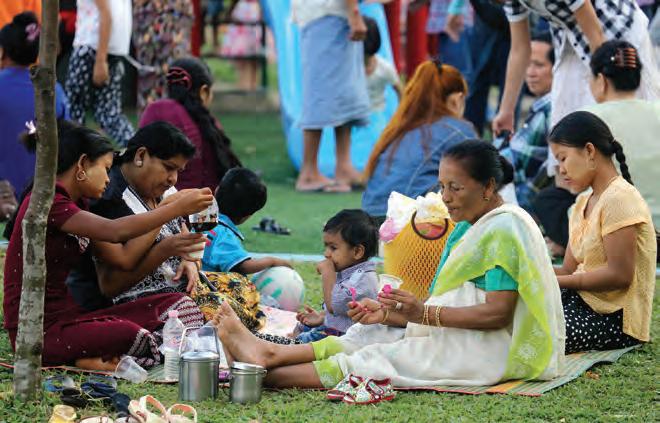
Park refurbishment has included repairing benches and moving vendors outside. Large palm trees were unfortunately replaced with decorative pom-pom poodle trees, offering little shade. Beds of yellow daisies are framed with hedged paths. There’s not a weed nor a piece of litter in sight, possibly due to the keen rubbish collector striding around clicking his tongs. But his bag is quite empty. People seem to realize and respect that this shared place comes with a responsibility to take care of it, not to trash it. Park regulations forbid betel, spitting, pets and picking flowers.
The view from this precious half acre beside Sule Pagoda which sits at the core of the street grid laid out by colonial city planners, is framed by striking architecture reflecting the city’s cosmopolitan multi-faith
character. Next to Sule Pagoda is Sunni Jamah Bengali Mosque, with Emmanuel Baptist Church nearby. The High Court and City Hall give an air of municipal and judicial authority to the landscape. The former Rowe & Co Department store currently under renovation adds a consumerist dimension to the rich architectural tale. It’s so photogenic that everyone is taking pictures of each other and of course “selfies”, against the striking background.
Come 4 pm, toddlers rule at the playground. Every swing, slide and bit of the new colourful climbing apparatus, complete with “fall-safe” ground cover, is in good use. Office workers arrive, as do courting couples. A guitar plays. There’s hardly a better place to be as golden Sule catches the last of the day’s rays.
It’s a pleasing thought that the rest of Yangon might take a lead from this well-nurtured piece of ground and the way it has been prepared and maintained. It’s a glimpse of what can be, offering insight into potential that could be realized in other areas of the city.

Maha Bandoola Garden park: Open 5:30 am to 6 pm
Entrance: Free. (Bathroom 200 kyat).
Ayear and half after the Me N Ma Girls signed an agreement with a US music label, Myanmar’s only pop girl band are in Los Angeles to record their first international album.
The group first signed a deal with Power House Music in June 2012 and travelled to LA last year to record a single entitled “Girl Strong,” an international pop style song.
In January this year, the band was nominated for an award in the Malaysia-based, Asia-wide VIMA Music Awards for 2014, the first time that a Myanmar band received a nomination. The winner will be announced on March 22 in Subang, Malaysia.
The group is moving on after a setback when two of the four mem-
bers departed in January, leaving singers Ah Moon and Kimi to carry on.
Members Hitke Hitke and Cha Cha left after disagreements arose over their recording contract, according to Ah Moon.
Ah Moon said Htike Htike and Cha Cha had been displeased to learn that their contract also gave the company ownership of any of their solo work. “The main reason for the split is that they want to be individual artists. Since signing the contract with the company, we are the artists of Power House Music; both our individual art activities and group work is owned by the company,” she said.
“The company also wants a 100-percent commitment on this album as we are a first starter,’’ she said.
Htike Htike told The Irrawaddy in January that she did not want to discuss leaving the band.

Daniel Hubbert, CEO of Power House Music, said in an email that Htike Htike and Cha Cha ‘‘weren’t as focused on the group as we would like them to be. In the end, we had to let them go, because it is the best thing for Ah Moon and Kimi’s careers.”
Myanmar’s only girl band was originally formed under the name the Tiger Girls in 2010 after five young women were scouted by Australian dancer Nicole May in a talent contest in Yangon. Ah Moon is an ethnic Kachin from Myitkyina, Kimi is a Chin from Kalaymyoe, and Htike Htike, Wai Hnin and Cha Cha are ethnic Myanmar girls from Yangon.
In 2011, the band was renamed the Me N Ma Girls. They quickly gained domestic and international attention as Myanmar’s first pop girl band and enjoyed a number of hit singles. Wai Hnin left the group in 2013. After the deal with Power House they performed live shows in Asia and Western countries.
One song on the planned new album has been written by Wendy Starland, songwriter for American pop star Lady Gaga. “There will be Myanmar songs too,’’ Ah Moon said.
The singer, who is also known by her Kachin name Lung Sitt Ja Moon, said her first music idol was Michael Jackson, while she also ranks contemporary artists like Rihanna, Beyoncé and Demi Lovato as inspirations.
“Myanmar’s famous singers Lay Phyu, Ahge and Myo Gyi from Iron Cross band and women singers Chan Chan, Irin Zin Mar Myint and Ni Ni Khin Zaw are also role models for me,” she said.

